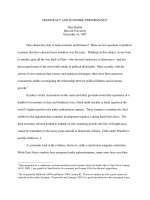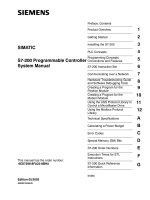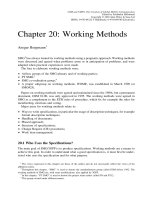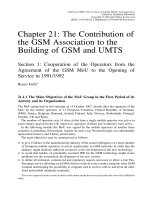Tài liệu Megacities and Climate Change ppt
Bạn đang xem bản rút gọn của tài liệu. Xem và tải ngay bản đầy đủ của tài liệu tại đây (3.03 MB, 31 trang )
LEAD International 2008
Megacities
and Climate Change
Sustainable urban living in a changing world
1
Preface2
Foreword3
Introduction5
Chapter 1Energy 8
Chapter 2TransportandUrbanMobility 20
Chapter 3WaterandSanitation 30
Chapter 4LanduseandUrbanPlanning 38
Key Messages 49
Useful Links 50
Authors 53
About LEAD 55
All rights reserved to LEAD International
Nothing from this publication may be reproduced, stored
in a computerised system or published in any form or in
any manner, including electronic, mechanical,
reprographic or photographic, without prior written
permission from
the publisher;
LEAD International
Sundial House
114 Kensington High Street
London W8 4NP
UK
The individual contributions in this publication
and any liabilities arising from them remain
the responsibility of the authors.
The publisher is not responsible for possible damages,
which could be a result of content derived from this
publication.
This publication was prepared for LEAD with
contributions from the following LEAD Fellows
Patricia Avila LEAD Mexico
Bharati Chaturvedi LEAD India
Nick Harrison LEAD Europe
Tiyok Prasetyoadi LEAD Indonesia
Melita Rogelj LEAD Europe
Theresa Subban LEAD South Eastern Africa
Erin Silsbe LEAD Canada
Edited by Fernando Monteiro, Boris Graizbord,
Manuela Bucciarelliand Nick Harrison
Contents
Megacities and Climate Change
Sustainableurbanlivinginachangingworld
2Megacities and Climate Change
3
thedevelopedanddevelopingworldpose
difficultquestionsabouthowtomanage
urbangrowthinthe21stcentury.Avoiding
themistakesmadeinNorthAmericancities,
whereurbanisationcoincidedwithalove
affairwiththecarisprovingtobeoneofthe
mostcomplexchallenges.Foodshortages,
naturaldisastersandwidespreadinequality
poseevengreaterthreatstothe40percent
oftheworld’spopulationlivingonlessthan
US$2aday.Themostvulnerableliveinthe
developingworld,wherethoseleastableto
protectthemselvescontributetheleastto
theworldwidetotalemissionsof
greenhousegases.TheUN’sHuman
DevelopmentReportcitesthatonan
averageannualbasis,onein19people
livinginthedevelopingworldwasaffected
byaclimatedisasterinthefirstyearsofthe
21stcentury.
Temperatureincreasesanddepletionofthe
earth’snaturalcapitalwillonlyexacerbate
theintensityandfrequencyofclimate
disasters.Thatbetterlivingconditionscan
beamelioratedbyadvancesinsustainable
urbandevelopmentispoorlyunderstood.
Toooftenpolicymakers,practitionersand
communityactivistslacktheknowledgeand
skill-settocreatemoresociallyand
economicallycohesivecommunities.Thisis
becauseofthedeepfragmentationthat
existswithintheprofessionsandbetween
variouslevelsofgovernment,butalso
becausetheplanningprocessand
developmentpoliciestypicallydonot
adequatelyintegrateenvironmental
considerationsorprioritisesocial
infrastructureearlyenough.Ittakesa
multi-sectorapproach,onesynthesising
financialandsocialimperativesaswellas
theenvironmentandphysicalform,to
respondtotheunpredictablechallenges
causedbyclimatechange.
Thebirthofthe21stcenturyinauguratedthe
firstageofcities,theUrbanAge.Withover
halftheworld’spopulationnowlivinginan
urbancentre,questionsabouthowwelive,
work,andmoveareincreasinglyfocusedon
thephysicalformofcitiesandtheirgreater
metropolitanregions.Ascentresfor
knowledge,citiesareincubatorsforchange.
Theyarealsothetestinggroundforcultural
regenerationandsocialintegration,
providingjobs,accesstoeducationand
healthcareforalargepercentageofthepoor
andtheemergingmiddleclass.Asthe
largestemitterofcarbonemissions,cities
exertanenormousinfluenceon
environmentalpressuresresultingfrom
climatechange.Andwiththeintuitive
rural-urbanmigrationcontinuingunabated,
citiesarethebattlefieldonwhichthefuture
ofhumanitywillbefought.
Whichurbanformsbestaccommodatethe
increasinglydiverseconstituencieslivingin
citiestoday?Andhowcantheruleoflaw
reconcilethetensionsbetweenspatialand
socialdisorder?UrbanAge,ajointinitiative
oftheLondonSchoolofEconomicsand
PoliticalScienceandDeutscheBank’sAlfred
HerrhausenSociety,isestablishinganew
agendaforthefutureofcitiesinorderto
promotethegrowthandsustainable
developmentofglobalcitiesinthe
developedanddevelopingworld.This
agendaisbeingcreatedinpartnershipwith
governmentagencies,researchinstitutions,
privatecorporationsandcivilsociety
organisationsattheinternational,central,
regional,stateandlocallevels.By
integratingtransversalthemessuchas
housing,migration,transportinfrastructure,
inequalityandviolence,includingthe
impacttheseissueshaveonthecreation
andmaintenanceofpublicspace,UrbanAge
ischartingthefutureofcitiesandclimate
changeisattheforefrontofthisagenda.
Urbangrowthpatternsandnetworksdefine
theglobalpoliticaleconomy.UnitedNations
projectionsforaworldpopulationofnine
billionby2050couldseeasmanyas75per
centlivingincities.AfricaandAsiaarethe
maindriversofthisincreaseasLatin
America,EuropeandNorthAmericahave
beenover75percenturbanisedsince2000.
Evenso,bothsmallandlargecitiesacross
For the first time in human history, more people are living in urban
areas than rural ones. This unprecedented and ongoing transition
coincides with alarming degradation of the natural environment.
With so many cities already experiencing the early impacts of
climate change there is an urgent need for action.
As climate change becomes more apparent it will have massive
implications for urban living across the world. Key urban services
like transport, water, energy and land use will all be adversely
affected. But while “business as usual” points to a disastrous future,
there are opportunities to be had from a different approach. With
the right leadership, cities offer the potential to be critical leverage
points for achieving a transition towards a more sustainable future.
If we can work towards making cities respond to the coming
challenges in a radical and far sighted way, the implications for
sustainability could be deep and profound.
How can cities adapt to the coming changes? How can cities point
the way to a different kind of low-carbon future? What lessons
can be learnt from experiences in the South and North? What
kind of leadership is required to identify, promote and deliver
the required changes?
Building on the diversity of experience, which is the trademark
of the global LEAD network, this publication brings together LEAD
Fellows who are working in the front line of efforts to promote
sustainability and urban living in very different contexts around
the world, to explore some of the challenges and potential solutions
to what needs to be done.
Focussing on the importance of leadership, LEAD’s main aim is to
contribute to the debate by promoting an exchange of views about
the role leadership plays in addressing climate change in large cities
and urban areas. We hope we can inspire and inform stakeholders and
decision makers to rise to the leadership challenge and act to secure
a sustainable future for our cities and the people who live in them.
LEAD International
Preface
Foreword
4Megacities and Climate Change
5
lowerrates(typically2%to3%).These
countriesareusuallybetterfinanciallyand
organisationallyequippedtorespondtothe
governanceandinfrastructurechallenges
ofsuchgrowthandprovideserviceslike
transportation,water,energyandsecurity.
2
Inbothcases,publicadministrationsface
considerablechallengesdue,notonlyto
lackofresources,butalsotolackofcapacity
whereitmattersmost,atthelocalthelevel.
Inthenext50years,whenglobalpopulation
growthstabilisesduetoadrasticreduction
inbothbirthanddeathrates,themost
denselypopulated,populousandsocially
fragmentedoftheseurbanagglomerations
willbelocatedinthedevelopingworld.
Alreadymorethanhalfoftheworld’s
populationnowliveinurbanareasandat
thebeginningofthiscentury,almostonein
tenofuswaslivinginoneof35megacities,
20ofwhicharelocatedinAsia,teninthe
Americas,threeinEuropeandtwoinAfrica.
3
Thisscenarioraisesconcerns,particularly
whenweconsidertheanticipatedimpact
ofclimatechange.Climatechangewill
requireadaptationsinthewaycitiesare
managedinordertoensuretheymaintain
livingstandardsandremainattractivetothe
investmentandhumanresourcesnecessary
tosupportsustainabledevelopment.
Megacities,aswellasrapidgrowingcities
intheSoutharemorevulnerabletosuch
impactsandarelesswellequippedto
adapt,bothorganisationallyandfinancially.
Competitiveness and vulnerability
of Megacities
Twointerrelatedfactorswillaffecttheway
megacitiesinthedevelopingworldmay
respondtothechallengesposedbyclimate
changeinthecomingyears.Ononehand,
megacitiesaretheenginesofglobalisation,
drivingtheflowofpeople,goods,
knowledge,andmoneyaroundtheworld.
Ontheotherhandtheyalsoembodyhuge
inequalitiesinthedistributionofwealth,
economicopportunityandexposureto
risks.Tenoftheworld’smosteconomically
importantcitiesareresponsiblefor20%of
theglobalgrossdomesticproduct(GDP)and
inseveralcountriesmegacitiescontribute
toaconsiderableportionofthecountry’s
output.Forexample,Tokyoishometo28%
oftheJapanesepopulation,andaccountsfor
40%ofthecountry’sGDP.Inthedeveloping
world,Lagosishometo8%ofNigeria’s
populationbutcontributes30%ofthe
country’soutput.Consideringtheir
“Whenweseeverydarkcloudsupthehills,
weexpectheavyrainstocome.Soweget
ourselvespreparedbytransferringour
valuablethingsonourveryhighbedswhich
arereachedbyclimbingladders.Also
childrenwhosleeponthefloorare
transferredtothehighbeds.”
MrsFatuTuray,KrooBaycommunity,
Freetown,SierraLeone.
1
Duringthepast50yearsmostlowand
middle-incomenationshaveexperienced
exceptionaldemographicgrowthwith
somecitiesundergoingmassivephysical
expansion.Thisprocesshasbeen
accompaniedbyalargeincreasein
thenumberofurbandwellerslivingin
povertyandlackingprovisionofthebasic
infrastructureandservicesthatshould
protectthemfrommostoftheearly
impactsofclimatechange.Morethanone
billionurbandwellersliveinpoor-quality,
overcrowdedhousingin‘slums’orinformal
settlements,andahighproportionofthese
settlementsareonsitesatriskfromflooding
orlandslides.
Manylowandmiddleincomecountries
arenowundergoingrapidurbanisation,and
duetotheirparticularsocialandeconomic
developmentcharacteristics,thisprocess
posesdistinctivechallengestopolicy
makers.Lowincomenationsarefacedwith
urbanisationintheformofemergingcities
whichhavehighpopulationgrowthratesin
largelyinformalsettlementsandareoften
unsupportedbyestablishedinfrastructure
orservices.Withgrowthratesbetween3%
to6%peryear,theseemergingcitiesare
typicallyfoundwithincountriesundergoing
demographictransitionfromruraltourban
areas.Peoplelivinginthesecitiestendto
beyounger,predominatelymalewithlow
levelsofeducationandtheyexperience
considerableinequalitiesinwealth,health,
educationandpoliticalpower.Inmiddle
incomenations,establishedcitiesalso
facecontinuedpopulationgrowthbutat
Coordinatedaction,pairedwithimmediate
interventionsandlong-termgoals,offers
convincingresultsabouttheeffectiveness
ofintegrateddevelopmentplans.Evidence
isfoundintheAlexandraRenewalPlan
inJohannesburg,whereaccountabilityto
jointadministrativeandpoliticalbodies
recognisesthatregenerationfails
whenapproachestocitybuildingare
uncoordinated.Congestionchargingin
Londonprovidesanexemplarymodel
forsustainableurbandevelopment,with
privatecarownershiptamedinfavourof
increasedinvestmentinpublictransport
andpublicspace.Furtherevidencecanbe
foundinthecaseofBogotá’sTransMilenio
busrapidtransitsystem,firstimplemented
inthesmallerscaledCuritibaandthen
adoptedinthemega-metropolisofMexico
City,whichcutcommutingtimesinhalf.
Thisboldmovedemonstratedhowsocial
andeconomicmobilitycanimprovequality
oflifewhilealsoreducingtheimpactof
humanactivityontheearth.
Citiescontributeover80percentofthe
world’scarbonemissions.Pollutionfrom
industrialactivityandtransport,inefficient
buildingperformanceorfuelefficiency
standards,andpoormanagementof
theearth’snaturalcapitalcanseemlike
insurmountabletasks.Yetasrecentlyas
20yearsago,NewYorkCitydumpedthe
majorityofthecity’srawhumanwaste
directlyintoitsrivernetwork.Although
thispracticecontinuesincitiesacrossthe
globe,localandinternationalenvironmental
groups,recognisingtheirroleaswatch-
guard,arehelpingtochangebehaviour.
Civicparticipation,inamultitudeofforms,
isfundamentaltoeffectivegovernance.
Participatorybudgetingandcommunity
advocacyfacilitateincreasedcommunication,
individualaccountabilityandcollective
activismtosupportacultureofshared
responsibility.
Introduction
OppositeAs recently as 20 years ago, New York City
dumped the majority of the city’s raw human waste
directly into its river network.
Integratedplanning–allowingpeopleto
liveclosertowheretheywork,providing
publictransportnearhousing,jobsand
therequisitesocialinfrastructure–arevital
elementsforthecreationofsustainable
cities.Compact,mixed-use,well-connected.
Thesequalities,pairedwithashared
responsibilityamongmultiplegovernment
agencies,businessleaders,policymakers,
academicsandurbanpractitionersand
facilitatedbyintergenerationalexchange,
willproducedynamicandrewardingresults
intheworld’sfinancialandculturalnerve
centres.Ourcommontaskistofulfilthe
hopefulpromiseofurbanlife,andnotlet
ourcitiesbecomehopelessfailures.The
nextgenerationmustbebroughtintothis
effortearly.Throughthepushandpull
betweengovernmentsandcitizens,private
interestsandpublicintervention,public
participationthroughallthestagesofcity
makingwilleasethechallengeofgetting
thedetailsright.
Urban Age Programme
London School of Economics and
Political Sciences – Deutsche Bank’s
Alfred Herrhausen Society
Policieswhichcombatsprawlandinstitute
betterwatermanagementandlanduse
policiescancreatemorecohesiveurban
environmentsandimprovequalityoflife.
Sincebuildingsconsumeclosetohalfthe
world’senergy,technologicalinnovations
andmaterialapplications,aswellas
increasedself-sufficiency,canhelp
reduceenergydemandsandeachcitizen’s
ecologicalfootprint.Butwedonothave
tostartfromscratch.Recyclingspaces,
materialsandinfrastructure,remediating
brownfieldsandincreasingdensityare
readilyavailabletoolswhichhelpretrofit
oururbanenvironmentsforincreased
populationgrowthandbetterdesigned
environments.Recyclingincreasesthe
wealthofallurbancitizens.Conservation
strategiesneednotbeacharacteristic
onlyofthepoor,bornoutofnecessity
orpublicmandate.Itcanbeacultural
valuesharedbyall.
Leadership,ofcourse,makesthedifference.
Bettergovernedcitiesarebetterequipped
todealwiththethreatsofclimatechange
sincethemostvulnerablecitiesarethose
inwhichdevelopmentdoesnotwork.Yet
thechallengeconfrontingpolicymakers
andpractitionersisnottogetdevelopment
rightfirst,andadjustfortheimpactof
climatechangeafter.Policiesandagencies
mustbealignedandgovernmentleaders
mustensurethatdevelopmentpriorities
areintegratedandmonitoredthroughout
allstagesofaproject.Ecologicallyand
economicallysustainablecommunities
canonlybecreatedthroughtheactive
participationfromawiderangeof
communitystakeholdersfromthe
beginning.Governmentsmustbe
willingtoshareinformationandideas,
andallowforcontinuousinvestmentin
aflexible,adaptiveurbaninfrastructure.
6Megacities and Climate Change
7
1Douglas,Ian,KurshidAlam,MaryAnneMaghenda,
YasminMcdonnell,LouiseMcLeanandJackCampbell(2008),
‘Unjustwaters:climatechange,floodingandtheurbanpoor
inAfrica’,EnvironmentandUrbanization,Vol.20,No.1.
2Foracomprehensivedescriptionofmegacitiesarchetypes
seethereport‘MegacitiesChallenges–astakeholderperspective’
byGlobescanandMRCMcLeanHazel.
3Graizbord,B.‘Megacities,MetropolitanAreasandLocal
Governments’LEADMexico,ElColegiodeMexico.
4Satterthwaite,D.etal‘AdaptingtoClimateChangeinUrbanAreas:
Thepossibilitiesandconstraintsinlow-andmiddle-incomenations’
HumanSettlementsGroupandtheClimateChangeGroupatthe
InternationalInstituteforEnvironmentandDevelopment(IIED)2008.
5Satter thwaite,D.etalop.cit.
6Satter thwaite,D.etalop.cit.
Equally,leadershipisrequiredfromthe
privatesectorbecauseoftheimportant
contributionsthatbusinessesandinvestors
canmakeinenablingtheimplementation
ofadaptationmeasures.Thisincludesnot
onlyadaptingtheirownoperationsand
infrastructurebutalsoindevelopinggoods
andservicesthatenableindividuals,
communitiesandgovernmentstoadapt.
Extendingappropriatefinancialservices
(particularlytolower-incomegroups)can
helphouseholdstoinvestinsaferhomes
andbuildbetterlivelihoodswhichinturn
strengthenresilienceandtheabilityto
adapt.Insurancewhilstnotonlyprotecting
buildingsandinfrastructure–ifappropriately
structured–canalsobeusedtoencourage
riskreduction.
6
Finally,civilsocietyandcitizensorganisations
haveanimportantroletoplay.Participation
mustfullytakeintoaccount,andallowfor,
theinvolvementofdiversecommunities
andthoserepresentingexcludedgroups
suchaswomen,theelderlyandtheyoung.
Newtechnologiesandmethodsof
communicationcanencourageandsupport
moreinteractivepolicyenvironments;
bringinggovernmentclosertothepeopleit
serves.Theinstitutionalandfinancial
arrangementsrequiredtocopewithclimate
changemustbedesignedtoensureahigha
degreeofequityandequalopportunity
amongthediversesocialgroupswhich
makeupurbanpopulations.Thiswillalso
requiregreaterpoolingofresources.
What lies ahead: challenges and
constraints in addressing urban
vulnerability to climate change
Someinnovativepoliciesandpractices
(largelydevelopedbycommunitybased
andurbanpovertyorganisations)have
shownthatitispossibletoreduce
vulnerabilitytotheimpactsofclimate
changeatrelativelylowcost.Therearealso
anincreasingnumberofexampleswhere
localgovernmentsworkinginpartnership
withlow-incomegroupshavesuccessfully
improvedinfrastructure,housingconditions,
anddevelopednew,good-quality
settlements.Eventhoughclimatechange
oftencompeteswithotherdemandsplaced
oncitygovernmentsandnationalministries,
liketheprovisionofbasicinfrastructure,
servicesandadequatehousing,webelieve
theseissuesshouldbeapproachedfroman
integratedperspectiveandaddressedtaking
climatechangeintoconsideration.
Thispublicationexploreshowmegacities
andrapidlygrowingcitiesarerespondingto
theurbandevelopmentchallenges
presentedbyclimatechange.Itprovides
examplesandcasestudiesofsuccessful
initiativeshighlightingtheleadership
requiredtotacklethisglobalproblem.The
followingchaptersofferarangeofinsights
andexamplesofinnovativesolutionsto
challengesinfourareasofurban
developmentthatwillbesignificantly
affectedbyclimatechange:waterand
sanitation;energy;transportandurban
mobility;landuseandurbanplanning.
havetoliveinsitesmoreexposedtodanger
fromclimatechangeimpacts.Theyare
oftenunabletomovetolessdangerous
areasasthemorevulnerablesitesare
oftentheonlyplaceswheretheurbanpoor
canfindaffordablehousingorbuildtheir
ownhomes.Majorchangesaretherefore
urgentlyrequiredinhowgovernments
(particularlythoseinlowandmiddle
incomecountries)improvetheresilience
oftheirinfrastructureandeconomiesto
dealwiththescaleofanticipatedclimate
changeimpacts.Nationalandcity
governmentsneedtofocusnotonlyon
improvingtheirabilitytorespondtothe
earlyimpactsofclimatechange,butalso
supportmeasureswhichreducetheir
vulnerabilitytofuturerisks.
Leadership and climate change
in rapidly urbanising settings
Leadershiptocopewiththechallenges
presentedbyclimatechangehavetotake
placeacrossallsectorsandlevels.Local
authorities,businessesandcommunitiesall
haveacrucialroletoplayinthisprocessas
adaptationtoclimatechangerequireslocal
knowledge,localskillsandlocalcapacity
toensuresolutionsareassustainable
aspossible.Weneedhouseholdsand
communityorganisationswiththe
knowledge,capacityandwilltoactanda
willingnessamonglocalauthoritiestopay
specialattentiontothevulnerabilityof
lower-incomegroups.Tobesuccessfulin
adaptingtoclimatechange,aprofoundshift
needstohappeninthewaylocalauthorities
engagewithlow-incomeurbandwellers,
whoaretheonesmostseverelyaffectedby
itsimpacts.
How climate change will increase urban
vulnerability and affect the poor
Thevulnerabilityofurbanpopulationsto
extremeweathereventshasbeenvividly
highlightedinrecentyearsbytheincrease
incausalitiesandmajoreconomiclosses
resultingfromhurricanes,stormsandfloods.
Scientificevidencepredictsthatsuchevents
willreoccurwithincreasingfrequency
andbeaccompaniedbyotherimpacts
suchasheatwaves,reductionsinfreshwater
availabilityandsea-levelrise,whichisa
particularchallengeforcoastalcities.The
majorityofdamagecausedbysuchevents
hashadfargreaterimpactonlowand
middleincomepopulations,largelydue
totheirincreasedvulnerabilityfrom
livinginhazardousconditionswithpoor
infrastructureandinadequatehousing.
AccordingtoSatterthwaite
5
,lowerincome
groupswillbeaffectedhardestbecause
theyaremoreexposedtohazardsand
possesslesscapacitytoadapt.Theyhave
lessstateprovisiontohelpthemcope,less
legalprotectionandlessprotectionfrom
insurance.Inurbanareas,suchgroupsoften
Themajorityofdamagecausedby
climatechangehashadfargreater
impactonlowandmiddleincome
populations,largelyduetotheir
increasedvulnerabilityfromliving
inhazardousconditions.
importancefornationaleconomies
andgrowth,megacitieshavetoremain
competitiveinordertoattractinvestment.
Toattractinvestment,thesecitiesneed
modern,efficientinfrastructures.They
requireeffectivetransportationsystems,
moderninformationandcommunication
technology(ICT)andprovisionofbasic
servicessuchaswaterandsanitation,access
toqualityhousing,education
andelectricity.Equallyimportantisthe
availabilityofskilledlabourandgovernance
systemsthatensureanenvironment
attractivetoinvestors.
How Climate Change may affect
urban competitiveness
Themostinfluentialdriverforurbanisationis
whereneworincreasingprivateinvestment
flows.Theflowofinvestmenthasastrong
influenceonhowindividualurbanareas
develop,andtheircompetitivenesslargely
dependsonhowattractivetheyareto
investors.Urbanareasvulnerableto
disruptionfromtheimpactsofclimate
changewillclearlybelessattractiveas
theyrepresentahigherinvestmentrisk.
Suchdisruptionalsoposesathreattourban
economiesasexistingbusinessesand
investorsmaydecidetomoveelsewhere
tomitigatedisruptiontotheiroperations
andrisktotheirinvestments.Evenifsuch
operationsarenotdirectlyaffectedbyan
extremeweatherevent,theindirect
impactsanddisruptiontoinfrastructure
andsupply-chainsorinconvenienceto
staffmayencouragemovementelsewhere
orthechoiceofnewlocationswhen
enterprisesexpand.
4
While every region of the world has a number of cities with over
1 million inhabitants, new megacities with over 10 million people
are developing across Asia, Africa, Central and South America.
©UrbanAge,LondonSchoolofEconomics,www.urban-age.net
Energy
1
10Megacities and Climate Change
11
Chapter1 Energy
Fortunatelymanysolutionstothese
problemsalreadyexist.Fordecades
now,peopleacrosstheplanethavebeen
workingtodevelopandimplementthem.
Newtechnologies,economicandpolicy
toolsalongwithnewapproachesto
influenceandchangesocial,organisational
andindividualbehaviourallexistandhave
demonstratedthattheycanwork.Sowhat
arethechallengesweneedtoovercome
toimplementthesesolutionsincities
acrosstheworld?
Thesupplyandcontroloffossilfuelshas
playedadefiningroleinshapingthepolitical
andeconomiclandscapeoftheworldover
thepasttwocenturies.Manyoftoday’s
mosteconomicallyandpoliticallypowerful
countriesconsumemoreenergyand
producemoregreenhousegasemissions
perpersonlargelybecauseharnessing
theenergyreleasedthroughburningfossil
fuelsiswhatenabledthemtobecome
sopowerfulinthefirstplace.Thepivotal
rolefossilfuelenergyhasplayed–through
industrialisation–inenablingtherapid
economicandsocialdevelopmentofa
fortunateminority,hasthereforeledto
thewidespreadbeliefthatsuchsources
ofenergyareaprerequisiteforeconomic
andsocialdevelopment.
However,ithasbecomeincreasingly
apparentevenforthefortunateminority,
thatthisfossilfuelpoweredapproachto
developmentsuffersfromtwomajorflaws.
Firstly,fossilfuelsarebecomingscarcer,
moreexpensiveandwillsoonbeunable
tosatisfytheincreasingenergydemands
ofagrowingglobalpopulation.Secondly
theprocessweusetotransformthese
fuelsintoproductsandserviceswevalueis
causingdestabilisationoftheglobalclimate
makingpartsoftheplanetincreasingly
inhospitableforhumanbeingstosurvive.
Thesetwoflawsarecurrentlyamongthe
mostdemandingdevelopmentchallenges
wefaceasaglobalcommunity.Weknow
theenergysourceswe’veusedtoenable
economicandsocialdevelopmentare
finiteandweknowthatusingtheminthe
wayswehave,andonthescalewehave,is
causingdangerous(andpossiblyirreversible)
imbalancesinglobalecosystems.Yetwe
continuetogrowinnumber,andsotoo
doesourthirstforenergy.
3
Ourcurrentpathisclearlyunsustainable
andthisislargelybecausewearemaking
amessofhowwemanageenergy.
4
Therefore,amajorpartofhowwesolve
theseproblemsmustinvolvechanging
howwemanageenergy.Inparticular
howwemanageitinourcities.We
needpracticalsolutionsandweneed
toimplementthemveryquickly.We
needtostopthereleaseofgreenhouse
gasesfromburningfossilfuelsand
switchtosuppliesofenergywhichare
environmentallybenignandsustainable.
Weneedtoreducedemandforenergy
byimprovingefficiencyinend-use
technology;
5
andweneedtodecentralise
ourgenerationandsupplyinfrastructure.
6
Weuseenergyincitiesinamultitudeof
ways.Someareobvioussuchasillumination,
heatingandcooling,motivepower,and
electricity.Andsomearelessobvioussuch
asenergywhichishiddenor‘embedded’
intheproductionofbuildings,infrastructure,
food,clothingandalltheotherstuffwe
usetosatisfyourneedsanddesiresfor
security,comfortandfulfilment.Ofallthese
uses,providingelectricityandheatingis
responsibleforaroundonequarterofall
human-inducedgreenhousegasemissions.
1
Itwillcomeaslittlesurprisethatthereis
considerablevariationintheintensitywith
whichenergyisusedacrosstheplanet.
Aswithgreenhousegasemissions,energy
usegenerallycorrelateswithacountry’s
incomeandlevelofdevelopment.For
example,during2004apersonlivingin
oneoftheworld’shighestincomecountries
usedaround22timesasmuchenergyas
someonelivinginoneoftheworld’slowest
incomecountries.Similarly,inthatsame
year,someonelivinginahighincome
countrywasresponsibleforemitting
around14timesasmuchcarbondioxide
assomeonelivinginalowincomecountry.
3
Nick Harrison and Melita Rogelj
Ofallhumanactivityknowntocontribute
toclimatechange,satisfyingourdemand
forprimaryenergyisbyfarthegreatest.
Generatingover70%ofthisenergyby
burningfossilfueloil,coalandnatural
gas,
1
energygenerationofthiskindis
nowresponsibleforaround60%ofour
greenhousegasemissionsworldwide.
2
Withthemajorityofour(fastgrowing)
populationandenergydemandnow
concentratedinurbanareas,thewaywe
useenergyinourcitiescurrentlyrepresents
oneofthesinglebiggestcausesofglobal
climatechangetoday.Henceanyone
consideringtheroleofcitiesinclimate
changeneedstobeginbyconsidering
howcitiesuseenergy.
Context
Apersonlivinginoneoftheworld’s
highestincomecountriesusesaround
22timesasmuchenergyassomeone
livinginoneoftheworld’slowest
incomecountries.
PreviouspageMost of the energy demanded in cities is used
within and by buildings and the relatively high initial cost of
energy efficient buildings has historically acted as a strong
disincentive to widespread deployment. Tokyo, Japan.
©NickHarrison
12Megacities and Climate Change
13
Chapter1 Energy
Intheremainderofthechapterwe
examinesomespecificchallengesfaced
inimplementingsolutionstomanaging
energybetterinourcities.Weillustrate
withexamplesdrawnfromtheworkof
LEADFellowshowthesechallengesare
beingsuccessfullyovercometoensure
moresustainableenergyuseincities
aroundtheworld.
Supplying Clean Sustainable Energy
Wehaveatourdisposalmanymethodsof
supplyingenergy(inusefulformslikeheat
andelectricity)whichwouldconsiderably
reduceourgreenhousegasemissions.
Theyincludethosecommonlyreferred
toas‘renewables’(Biomass,Geothermal,
Hydro,Ocean,SolarandWind)andNuclear
fission.Eachhasrelativeadvantages
anddisadvantagesandallfacevarious
challengestoplayingalargerroleinthe
globalenergysupplymix.Carboncapture
andstoragealsohasasignificantand
immediateroletoplayasatransition
technologyenablingustocontinueusing
energyreleasedfromburningfossilfuelsin
wayswhichcurtailemissionsofgreenhouse
gasesintheprocess.
8
Oneofthebiggestchallengestodeveloping
thesupplyofsustainableenergyhas
beentoovercomeitscostdisadvantage
against(oftenheavily-subsidisedand
environmentallypolluting)fossilfuelenergy
supplies.Establishing‘PowerPurchase
Agreements’and‘Feed-inTariffs’which
placealegalobligationonutilitycompanies
tobuyelectricityfromsustainablesources
atapremiumrateoveraguaranteed
periodareapproacheswhichhaveproved
successfulinanumberofcountriesalready.
Theymaketheinstallationofsustainable
energysystemsamoresecureandviable
investmentandoftenleadtothecreation
ofwholenewdomesticindustries.In
Germanyforexample,theintroductionof
Feed-inTariffscatalysedthedevelopment
ofitssolarindustryleadingthecountry
tobecomeaworldleaderwith40,000
nowemployedinthesector.
9
Withoutthe
supportofsuchlegislation,whileinvestment
maybeavailableforlargeprojectswith
evidentprofitmargins,itisnotalways
easytosecuresuchinvestmentforearly
projectdevelopment(suchascapacity
measurements,communityassessments
orskillstraining)allofwhicharenecessary
toenableequitabledeploymentof
renewableenergytechnology.Asa
resultoflegislativechangessuchasthese,
globalinvestmentinsustainableenergyis
growingrapidly.In2007theamountofnew
investmentincreased60%ontheprevious
yearto$148.4billion
10
andrecentreports
indicateanincreasingnumberofcountries
arenowputtingtheminplace.
11
Legislationcanalsobeachallengeto
implementingsustainableenergyandone
suchexampleistheobligationoftenplaced
onpublicauthoritiestodeliverservicesat
thelowestfinancialcosttothetax-payer.
Thisisoftencitedasabarriertoaction,but
canbeovercomethroughchangesinhow
wevalueecosystemservices.Forexample,
anapproachbeingtakenbyMexico’s
state-runelectricitycompanyCFE,isto
pursueprinciplesoffullcostaccounting
whichemphasisecosttothetax-payer
notonlyinfinancialtermsbutalsointerms
ofcosttosocietyandtheenvironment.
12
Acrosstheworld,mostcitiesalready
haveorareintheprocessofdeveloping
strategies,policiesandplansaddressing
climatechangeandfutureenergyneeds.
Butimplementingthesemanyandvaried
frameworks–inwaysleadingtoactual
emissionsreductions–isstillgenerally
atanearlystage(EPC,2008).Clearlythe
scaleandtypeoftransformationdemanded
byourcurrentsituationrepresentshuge
challengesbothorganisationallyand
politically.Challengessuchasthetendency
toobfuscatethecausesandpotential
solutions;poorleadership;silo-working;
andabsentordysfunctionalincentives
mustallbeovercomeifwearetosucceed.
7
Challenges
China has recently surpassed the United States as
the world’s biggest carbon dioxide emitter and it
is developing renewable technologies expected
to supply 10 per cent of its energy needs by 2020.
©RyanPyle-CourtesyofUrbanAge,LondonSchool
ofEconomics,www.urban-age.net
Asidefromchanginglegislation,
governmentsthemselvesalsooffergreat
potentialtoleadthetake-upofrenewable
energytechnologythroughchangesintheir
ownprocurementpolicies.Forexample,
acrossEurope,anincreasingnumberof
governmentsarenowprogressinginthis
waybyfinancingtheconstructionof
renewableenergyprojectsusingpublic
finance.Insomecases,citiesareworking
withlocalmunicipalutilitiestoconstruct
windturbines.Inothercases,theyare
workingwithprivatelyownedutilitiesand
renewableenergydeveloperstoconstruct
solararraysoncitybuildings,schools,and
homes.Anumberofcitiesarebeginningto
incorporaterenewableenergyrequirements
intotheircontractrenewalswithprivately
ownedlocalutilities.PlaceslikeGüssingand
LinzinAustria,ApeldoornintheNetherlands
andFreiburginGermany,areallexamples
ofwherecommunityandgovernmentled
effortsarehavingconsiderablesuccess.
14Megacities and Climate Change
15Lorem ipsum
Leadership which made it possible
Thenewlawcameaboutasaresultofthe
effortsoftheBrazilianSolarCitiesInitiative–
ajointprojectoftheVitaeCivilisInstitute,
anon-governmentalorganisationmanaged
byLEADFellowRubensBornandthe
BrazilianSWHmanufacturersassociation
(DASOLAbrava).ThecreationofSãoPaulo’s
solarlawcoincidedwiththecreationof
otherlawstoboostSWHintheBrazilian
citiesofPortoAlegre,BeloHorizonte,
CampinaGrandeand12others.The
initiativehasalsobegundiscussionswith
manyotherBrazilianmunicipalitieswhoare
nowconsideringfollowingSaoPaulo’slead
andintroducingsimilarlawsthatobligeor
createincentiveprogramsforinstallingSWH.
Theenvironmentalconcernsofcustomers
togetherwiththeintroductionofthesenew
municipallawsandspecialinstallationloans
haveledtoaboominthesalesofSWH
acrossBrazil.Asaconsequence,SWH
manufacturersarebusypreparingtosupply
thegrowingdemand,forecastinggrowthof
morethan30%thisyearwithsome
planningtodoubletheirproductionby2009.
TherapidgrowthinmembershipoftheSolar
CitiesInitiativenetworkandthenumberof
projectsmotivatedbyitsworkisclear
evidenceofitsimpactandimportance.The
initiativeaimstocontinuepromotingSWH
untilatleast2010whenithopestoseesolar
lawsinitiatedacross40Braziliancities.
Further information
www.vitaecivilis.org.br
Case study Solar Cities Initiative
Location Sao Paulo, Brazil
Overview of problem and solution
SãoPauloinBrazilintroducedmunicipal
lawsin2008requiringtheinstallationand
useofSolarWaterHeaters(SWH)inallnew
buildings.Thelegislationisamajorstepto
encourageawidespreadshifttoa
decentralised,sustainableenergysupplyin
oneofthelargestcitiesonearth.
Richinsolarresources,theentirecountry
receivesover2,200hoursofdirectsunlight
eachyear.However,electricityisstillused
considerablymorethanSWHtosupplyhot
water.Showerheadsandwaterheaters
currentlyrepresentaround6%ofBrazil’s
totalelectricityconsumptionandaround
25%ofthesystem’speakdemand.The
electricitytosupplythisconsumptionis
generatedmainlybyhydroelectricfacilities,
whichoftenputpressureonthe
environmentandtraditionalcommunities
re-locatedduringconstruction.The
expansionofthecountry’sgeneration
systemhasrecentlyinvolvedinvestmentsin
diesel,gasandcoal-firedthermoelectric
plantswhichincreasegreenhousegas
emissions,contributingtoglobalwarming
andincreasingairpollution.
Thenewlawswillhelptoovercomesomeof
thebarriersfacedintheimplementationof
SWHtechnologysuchastherelativelyhigh
initialcostofinstallation(comparedto
electricheaters)andthelackoflowinterest
creditforfinancingsuchinstallations.Other
benefits(besidesreducingcarbon
emissions)includebetteruseof
hydroelectricityinBrazil’senergymatrix,the
creationofskilledjobsandthereductionof
resourcesneededforbuildingelectrical
generation,transmissionanddistribution
infrastructure.
Case study 1
OppositeIn Sao Paulo, Brazil, a new legislation
requiring the installation and use of Solar Water
Heaters in all new buildings is a major step to
encourage a widespread shift to a decentralised,
sustainable energy supply. ©NickHarrison
16Megacities and Climate Change
17
Chapter1 Energy
Providingincentivestodothisisshownto
beworkinginmanyplacesaswehaveseen
withFeed-inTariffsmakingthedeployment
oflocalisedenergysupplyinfrastructure
morefinancialviable.Anotherapproachis
directsubsidiessuchasCalifornia’smillion
solarroofscampaign
17
whichhasdramatically
increaseddemandandtake-upofsolar
poweredelectricgenerationtechnology
byproviding$3bnstategovernmentsupport
forinstallation.Otherapproachesfocuson
encouragingtheinclusionoflocaloron-site
generationinnewdevelopments.Agood
exampleofthisisanapproachpioneered
bytheLondonBoroughofMertonintheUK.
TheMertonRule
18
isaplanningpolicywhich
statesthatallresidentialdevelopments
above1,000squaremetersareexpected
toincorporaterenewableenergytechnology
togenerateatleast10%ofpredicted
requirementson-site.Thepolicy,endorsed
bytheUKgovernmentin2006isnow
seeingwidespreadadoptionincities
acrosstheUK.
Settingtoughefficiencystandardsfor
manufacturersofend-usetechnology
suchaslighting,computersandtelevisions
alsoposesasignificantchallengefor
governments,particularlywhenresisting
effortsbyindustrytolobbyforlower
(cheapertoimplement)standards.
Japan’s‘Top-RunnerProgramme’
15
which
wasintroducedin1998isanexampleofa
practicalandeffectiveregulatorymechanism
whichensuresmanufacturerscontinually
worktoimprovetheenergyefficiencyof
theirproducts.Ratherthanjustsetting
minimumefficiencyperformancestandards,
thetop-runnerprogrammecontinually
searchesforthemostefficientmodel
currentlyonthemarketandstipulatesthat
thisbecomethecountry’sindustrystandard
minimuminagivennumberofyears.
Coveringproductsinover21categories,
theprogrammeisaworldleadingapproach
indrivingupefficiencystandards.
Anotherkeychallengetoreducingdemand
ispromotingbehaviourchangeamong
energyend-usersandinmanycountries
considerableeffortsarebeingmade
toinfluenceuserbehaviourwithsome
degreeofsuccess.Forexample,inTokyo
morethan2millioncitizenshavevoluntarily
pledgedtoreducetheirpersonalenergy-use
throughanovelonlineschemewhichis
havingconsiderableimpact.Nonetheless
changinguser’sbehaviourparticularlyin
highincomecountrieswhereadoctrineof
highconsumptionprevailsisaformidable
challengeandrelyingonvoluntary
reductionsaloneisunlikelytosucceed.
Decentralising Energy Supply
Climatechangeisanenergyissue,
energyisaninfrastructureissue,therefore
climatechangeisaninfrastructureissue,
accordingtoenergyexpertWaltPatterson
16
whoarguesthatchangingourenergy
infrastructureiskeytotacklingclimate
change.Conventionalenergyinfrastructure
tendstogenerateelectricityinlarge
centralisedpowerstations,transmitting
itoverlongdistancestoitsend-useina
waywhichisnotonlyinefficientbutalso
lacksflexibilityandmakesusersdependent
andvulnerabletowidespreadpower-outs.
Soweneedtomakeatransitiontomore
decentralisedenergyinfrastructureandthis
requiresnewemphasisinthedevelopment
andregenerationofourtownsandcities.
Inplaceswherelittleornoexisting
infrastructurecurrentlyexists,itmaysimply
beaquestionofensuringdevelopment
followsadecentraliseddesign.What
maybemorechallengingisretrofitting
adecentraliseddesigntoexisting
(centralised)infrastructures.
Whilstthisisbecominganincreasingly
effectivemechanismtodrivedemand
andinnovation,ashortageofskills
andknowledge(inbuiltenvironment
professions)neededtomeetthisdemand,
remainsachallengeintheshort-term.
Whatisperhapsevenmorechallengingis
howtoimprovetheefficiencyofexisting
buildings.IntheCityofBerkeley,California
thegovernmenthassuccessfullyusedits
legislativepowerstointroduceEnergy
ConservationOrdinances
13
ensuringwhen
apropertyissoldonitlegallyhastobe
refittedwithenergyconservationmeasures.
Theseordinancesareprovingtobean
excellentapproachtohousingstockrenewal,
ensuringarapidtransitiontowidespread
improvementsinenergyuseefficiency
inbuildingsacrossthecity.
Butit’snotjustthebuildingsthemselves
whichuseenergyit’salsotheend-use
technologieswithinbuildingswhichneed
improving.Manyinnovationsinend-use
technologiessuchasairconditioningand
refrigeratorsexistbuttheirhigherinitial
costisoftenabarriertowidespreadadoption.
InMexicoCity,aprogrammeoperatedby
agovernmentbackedtrustfund(FIDE)
andthestate-runelectricitycompany(CFE)
hasdemonstratedhowinnovativeuseof
subsidiescanhelpovercomethischallenge
makingsuchend-usetechnologiesmore
pricecompetitive.
14
Theapproachusesthe
costsavingsaccruedfromoperatingnew,
energyefficienttechnologytopayoffa
loanprovidedtocovertheadditionalcostof
purchasingthenewtechnology.Thescheme
coverslighting,insulation,refrigerationand
airconditioningandoverthepast15years,
hasfundedthereplacementofovereight
millionrefrigeratorswithnewenergy
efficientversions.
Improving Energy Efficiency
& Reducing Demand
Mostoftheenergywedemandincitiesis
usedwithinandbybuildingsandwhilemany
innovativeexamplesofenergyefficient
buildingsnowexist,theirrelativelyhigh
initialcosthashistoricallyactedasastrong
disincentivetowidespreaddeployment.
Governmentshavebeguntoaddressthis
challengebyimplementingstandardsand
targetsrequiringnewbuildingsbedesigned
andconstructedtouseenergymuchmore
efficiently(e.g.theUK’sgovernment’s
energyperformancecertificatesandtargets
forallnewbuildingstobezero-carbon
by2016).Insomecasesgovernments
areusingtheirownbuildingstoshowcase
goodpractice(e.g.theCaliforniaState
DepartmentofWaterandPowerand
DepartmentofTransporthaveincorporated
energyefficiencyandrenewableenergy
technologyintonewandexisting
officebuildings).
Weneedtomakeatransitiontomore
decentralisedenergyinfrastructure
andthisrequiresnewemphasisin
thedevelopmentandregeneration
ofourtownsandcities.
California Department of Transport building
showcases cutting edge low-energy design
©2007NickHarrison
18Megacities and Climate Change
19
Chapter1 Energy
Thechallengeshighlightedherearejusta
fewamongmanythatneedtobeovercome
ifwearetotackleclimatechangeand
ensuresustainableenergysupplyinour
cities.Manyarenowdedicatedtothistask
andrecenteconomicandpolicyshiftsare
alsohelping.Thegrowingglobalpriceof
fossilfuelsismakingalternativeenergy
sourcesandreductionstodemandallthe
morepoliticallyandeconomicallyattractive.
Meanwhile,thegrowingstabilityofthe
carbonmarketsandprogresstowards
morewidespreadlegislative‘caps’to
greenhousegasemissionsisdrivingmore
investmentin,anddemandfor,innovative
renewableenergyandenergyefficiency
(‘greentech’)technologythaneverbefore.
21
Sowheresomeseeachallenge,others
seeopportunity.
Leadership which made it possible
Themunicipalgovernment,drivenbythe
leadershipofitschiefengineerAllenJones,
pioneeredthedevelopmentofanetwork
ofover60localgeneratorswhichincluded
photovoltaicarraysandahydrogenfuelcell
stationtopower,heatandcoolmunicipal
buildingsandsocialhousing.Decentralising
theirenergysupplyhasenabledWoking
counciltoslashtheirenergyusebynearly
half,andCO2emissionsbyover75%,
since1990.
Developingaprivate,locallyowned
electricitynetworkenabledtheESCO
toavoidchargesusuallyassociatedwith
theuseofthenationalelectricitygrid.
Bycircumventingthesecosts,ithasbeen
abletofundwiresandgenerationtodeliver
lowemissionelectricitywhichiscost
competitivewithconventionalsuppliers.
LocalESCOsofthiskindarecurrentlybeing
developedacrosstheUK,mostnotablyin
LondonwhereWoking’spioneeringchief
engineerwassubsequentlyrecruitedby
themayorofLondontoimplementthe
UKcapital’senergystrategy.
20
Further information
Examplesofmanyofthesystemsinstalled
canbefoundontheWokingwebsite:
www.woking.gov.uk/environment/
Greeninitiatives/sustainablewoking
Case study Decentralising
Urban Energy Supply
Location Woking, UK
Overview of the problem and solution
Tocombattheinefficienciesand
vulnerabilitiesofacentralisedenergy
supplyinfrastructure,itisessentialwefind
waystodecentralise.WokingintheUKis
anexcellentexampleofhowitispossible
tomakethetransitiontoadecentralised,
sustainableenergysupplysysteminan
urbansetting.Withapopulationofjust
100,000,ithasinstallednearly10%ofallUK
solarphotovoltaiccapacityandishometo
thefirstfuelcellcombinedheatandpower
systeminthecountry.
Partofthesolutionwastoestablisha
networkofprivateelectricitywiresowned
andoperatedbyalocalEnergyService
Company(ESCO)whichwasestablished
andmajorityownedbythelocal
government,WokingBoroughCouncil.
Theseprivatewiresconnecttogether
thedispersedgeneratorscreatingalocal
supplynetworkandby2003thecouncil’s
electricityinfrastructurebecameover
99%independentofthenationalgrid.
Wokingwasabletoraisecapitalforenergy
infrastructuredevelopmentinitiallythrough
energyefficiencysavings.Thiswasachieved
byestablishingafundintowhichsavings
(belowabenchmarkofexpectedenergy
expenditure)accruedfromenergyefficiency
measureswerereinvested,yearonyear,
intofurtherenergy-savingmeasures.
Thesubstantialfinancialsavingsaccrued,
allowedthecounciltoinvestmillionsin
energysupplyinnovation.TheESCO
(ThamesweyEnergy)
19
subsequently
attractedinvestmentfrompension
companieswhorecognisedthesteady
low-riskreturntheinitiativeoffers.
Case study 2
Yetthescaleofthetaskbeforeusremains
hugeanditrequiresleadershipbothto
initiatethesolutionsandtoovercomethe
challengesifwearetomakethetransition
tocitiesofthefuturewhereenergyis
generatedandusedlocally,efficiently
andsustainably.
1WorldEnergyOutlook2006.InternationalEnergyAgency.
www.worldenergyoutlook.org
2WorldGreenhousegasemissionsbysector.UNEP.http://maps.
grida.no/go/graphic/world-greenhouse-gas-emissions-by-sector
3Fightingclimatechange:Humansolidarityinadividedworld.
UnitedNationsDevelopmentProgrammeHumanDevelopment
Report2007/2008. />4 Patterson,W(2008).ManagingEnergyWrong.ChathamHouse.
www.chathamhouse.org.uk/publications/papers/view/-/id/629/
5 Froggett,A(2008).TheInternationalClimateAgenda:
OpportunitiesfortheG8.ChathamHouse.
www.chathamhouse.org.uk/publications/papers/view/-/id/620/
6 Patterson,W.(2007).Transformingourenergywithina
generation.ChathamHouse.www.chathamhouse.org.uk/
research/eedp/papers/view/-/id/496/
7 Baserman,Max,H.(2006)ClimateChangeasaPredictable
Surprise.Negotiation,OrganisationsandMarketsResearchPapers.
HarvardUniversity. />cfm?abstract_id=785990&rec=1&srcabs=869644
8 Nature(2008).ElectricitywithoutCarbon.Vol.454.p816-823
www.nature.com/news/2008/080813/pdf/454816a.pdf
9 Lander,M(2008).GermanyDebatesSubsidiesforSolarIndustry.
NewYorkTimes. />10 GlobalTrendsinSustainableEnergyInvestment2008Report.SEFI
/UNEP/BASE/UNF. />11 Renewables2007GlobalStatusReport.REN21.www.ren21.net/
globalstatusreport/default.asp
12 www.energypolicyclimate.org
13 ResidentialEnergyConservationOrdinances,Berkeley,USA.
www.ci.berkeley.ca.us/sustainable/residents/ResSidebar/RECO.html
14 TheElectricPowerSavingTrustFund,Mexico
www.fide.org.mx/index2.html
15 TheTop-RunnerProgramme,Japan
www.eccj.or.jp/top_runner/index.html
16 Patterson,W.(2007).Keepingthelightson:towards
sustainableelectricity.ChathamHouse/Earthscan.
17 MillionSolarRoofsCampaign.California,USA.
www.environmentcalifornia.org/energy/million-solar-roofs
18 TheMertonRule,UK.www.themertonrule.org
19 www.woking.gov.uk/environment/climate/Greeninitiatives/
sustainablewoking/thamesweyenergy
20 Examplesofdecentralisingsupplyonalargerscalecan
befoundontheLondonClimateChangeAgency’swebsite:
www.edfenergy.com/lesco
21 Carbon2008:Post-2012isnow.PointCarbon.www.pointcarbon.
com/research/carbonmarketresearch/analyst/1.912721
OppositeEnergy use in Mexico City: in 2000,
Mexico City demanded 17% of the country’s
total energy fuels output. ©NickHarrison
21Lorem ipsum
Transport
and Urban Mobility
2
22Megacities and Climate Change
23
Chapter2 Transport and urban mobility
Adaptingtotheimpactsofclimatechange
caneitherbereactiveoranticipatory.Given
thatinfrastructureandlandusedecisions
beingmadetodaycouldhaveanimpact
onthefootprintofaregionforthenext
hundredormoreyears,incorporating
climatechangeconsiderationsintodecision
makingprocessesisanurgentpriority.
Dependingonhowquicklyglobalemissions
arestabilised,theclimateimpactswecould
faceoverthecomingcenturycouldbe
significant.Citiesthataredesignedandbuilt
toprovidemultipletransportationchoices
foritscitizenssuchasplanningwhichallows
peoplethechoicetowalk,bike,ortake
transit,tomeettheirbasicneedswillenable
thatcitytobemoreresilientinthefaceof
newchallengesassociatedwiththe
changingclimate.Thistypeofholisticurban
planningstrategywillhelplocal
governmentsdefinemoresustainable
pathwaysfortheirfuturegrowthandin
doingsofacilitateahostofotherbenefits
likeimprovedairquality,improved
liveabilityandenergysavings.Specific
transportationadaptationstrategiesthat
maybeincorporatedintoanoverall
sustainabilityplanmightinclude:storm
waterretentionponds;highercapacity
drainage;perviouspavingmaterial;building
standardsthatoptimizenaturalheatingand
cooling;coolingcentres;information
campaignsandfloodwarningsystems.
Giventhatadaptationisarelativelynew
conceptformostlocalgovernments,the
developmentofnewmodels,tools,and
dataaboutthepotentialimpactsand
vulnerabilitiesfromclimatechangeonthe
transportationsector,areurgentlyneeded.
Infactseverallocalgovernments
8
around
theworldareleadingthewayonthis
emergingissue(seeToronto,Canadacase
study).Withcriticalinformationinhand
includingnewlydevelopedbestpractices,
urbangovernmentswillbeinabetter
positiontobuildtheirresiliencyinadvance
ofanymajororenduringclimaterelated
events.Whileavailabilityofinformationisa
significantchallenge,itisonlyoneofmany
beingfacedbylocalgovernments
attemptingtoimplementmoresustainable
policyoptions.Thefollowingsection
outlinesinmoredetailsomeoftheother
keychallenges.
ascitiesgrow,averageincomestendto
growwhichinturnleadstoincreasesin
carownership–andurbandevelopment
patterns.Megacities,mostcommoninthe
developingworld,areoftencharacterised
bysprawling,disconnected,low-density,
landusepatternswithrapidlygrowing
populations.Thispatternoftenmakes
theprovisionofabalancedtransportation
networktoocostlytomaintainand
subsequentlyencouragestheuseofprivate
vehicles.Bothofthesefactorscanalso
contributetoweakeningdemandforpublic
transportandaconsequentdeclinein
servicelevels,patronageandfinancial
viability.Infrastructureforpedestrianand
othernon-motorizedtransportalsosuffers
aspublicfundstendtobefocussedon
roadmaintenanceandexpansion.
Vehicleuseisalsoencouraged,either
directlyorindirectly,throughsuchthingsas
propertytaxes,fuelsubsidies,andnear-term
planninghorizons.Forexample,politicians
tendtofocusonshorttermfixessuchas
expandingroadwaystoalleviatetraffic
congestioneventhoughthisisabattlethat
cannotbewongiventherapiddevelopment
ofcities.ArecentstudyintheUnitedStates
foundthatthroughtheimplementationof
sustainablelandusepolicyalone(i.e.policy
thatfocusesoncompactdevelopment
featuringamixoflanduses,interconnection
ofstreets,pedestrianandtransit-oriented
design)totalUStransportationrelatedCO2
emissionscouldbereducedby7–10percent
by2050.
3
GiventhattheUSisamongstthe
world’stopgreenhousegasemitter,this
analysishighlightsthecriticalimportance
oftraveldemandmeasures,suchas‘Smart
growth’,inthefightagainstclimatechange.
Transit-orienteddevelopmentisagood
exampleofsustainablelanduseplanning.
Thisisaregionalplanningconceptdeveloped
byPeterCalthorpe,about15yearsago
duringthestartofthe‘newurbanism’
movementintheUnitedStates.Itchannels
growthintodiscretenodesalonglight-rail
andbusnetworksandexploitsabasic
relationshipbetweentransportationand
landuse:putmoreoriginanddestination
pointswithinaneasywalkofatransit
stopandmorepeoplewillusetransit
4
(SeeJakarta,Indonesiacasestudy).
Coupledwithothertransportationmitigation
strategiessuchasfuelandvehicleefficiency,
roadtolls,congestionpricing,establishing
no-drivedaysorno-drivezones,other
feesandtaxesondrivingorparking,the
transportationsectorcanandmustplay
asignificantroleinclimatechange
mitigationstrategies.
Transportation & Adaptation
Thetransportationsector,bothits
infrastructureandusers,arehighly
vulnerabletoclimatechange.
5
Changes
inprecipitationpatternsforexample,may
leadtoincreasederosion,landslides,and
floodingwhichcaninturncausedamageto
roadways,bridgesandseawalls.Incoastal
regions,portactivitywillbeaffectedby
risingsealevels,stormsurgesandflooding.
Airportsareoftendisruptedbysevere
stormsandfloodingespeciallyinlow-lying
areas.Floodingofurbanundergroundrail
systemshasalreadycausedseriousdamage
anddisruptiontoserviceincitiesaroundthe
worldincludingPrague,Boston,NewYork,
Seoul,andTaipei.Onwarmerdays,non
air-conditionedpublictransportationcan
beunbearableformanyandcaninturn
beanincentivefordriving.Warmer
temperaturesalsoleadtothecreation
ofmoresmog,asignificantpublichealth
concern,whichisfurtherexacerbated
byincreasedvehicleusage.
AstudycarriedoutintheGulfCoastof
theUnitedStatesontheimpactsofclimate
changeandvariabilityontransportation
systemsandinfrastructure,foundthatthe
region’sentiretransportationnetwork
wouldbeexposedtopotentiallydevastating
consequencesifanysignificantsealevel
riseweretooccur.Impactsincluded:75%
oftheportfacilitieswouldbevulnerable;
eightmajorairportswouldbeinundated;
and25%oftheinterstatehighwaywould
beflooded.
6
Thestudyconcludedthat
practicalstepsneededtobetakento
buildtheresiliencyofthetransportation
systemsuchashardening,raising,or
evenrelocatingstructuresandexpanding
redundantsystems.
7
vehicles(motorcycle,truck,car).Road
transportationisresponsibleformostofthe
transportsector’simpactonhumanhealth
andtheenvironmentinOECDcountries
andisattheheartoftwodailychallenges
beingfacedbycities:airpollutionandtraffic
congestion.Inmostcities,theimpactofthe
transportationsectoronclimatechange
(andviceversa)isgenerallynotthegreatest
concerngiventheseotherseeminglymore
pressingissues.However,strategiesto
reducegreenhousegasemissionsoften
havemanyotherco-benefitsincluding
improvingairquality.
Thischapterwillfocusontheconnections
betweentransportationandclimatechange
andsomeofthechallengesbeingfacedby
citiesinimplementingsustainable
transportationpolicy.
Transportation and Mitigation
Thetransportationsectoraloneisresponsible
for14%oftheworld’sgreenhousegas
emissions,10%ofwhichcomefrom
roadtransportation(theremainingfrom
air,ship,andrail).
2
Emissionsfromroad
transportationaregovernedbythree
factors:vehicleefficiency,fuelefficiency,
andvehiclekilometrestravelled(VKT).
Todate,muchoftheclimatepolicy
discussionandmitigationactivityinthe
transportationsectorhasfocusedon
improvingfuelefficiencyandpromoting
cleanerfuels.Whilethesearenecessary
steps,theemissionsresultingfromthe
steepgrowthinVKT,especiallyinthe
developingworld,willfaroutstripany
reductionsgainedbythesetwomeasures.
By2030thereisexpectedtobemore
vehiclesinthedevelopingworldthanin
developedcountries.Thisrapidrisein
vehicleownershipanduseisparticularly
predominantinemergingeconomiesand
islargelytheresultofrisingincomelevels–
Erin Silsbe and Tiyok Prasetyoadi
AccordingtotheUnitedNations,virtually
allpopulationgrowthfromnowuntil2030
willbeconcentratedintheurbanareas
oftheworld;mostoccurringintheleast
developedregions.
1
Thisdevelopment
trendhassignificantimplicationsfor
climatechangepolicy.Citygovernments
areresponsibleforawealthofpublic
policydecisionscoveringareasasdiverse
asemergencymanagement,landuse
andbuildingscodes,energysupply,public
healthandsafety,waste,water,public
transportationandtransportinfrastructure.
Decisionsaroundtheselocalgovernance
issuescanhavesignificantimpactsona
region’scarbonfootprintaswellasits
abilitytorespondtoclimaterelatedevents.
Ascitiesgrowandbecomemoreinvolved
inglobaltrade,theefficientmovement
ofpeopleandgoodsiscriticaltoits
economicwell-being.Transportation
systemsareseenasoneofthebiggest
challengesinaccommodatingthe
growthofcitiesastheyprovidethe
fundamentalinfrastructurewhichenables
competitiveness.Transportationmodes
canbedividedintotwomajorsystems;
publicandprivate.Publictransportationin
citiesincludestrains(subway,elevated),
busesandtaxis,whileprivatetransportation
modesincludecycling,walkingandmotor
Context
By2030thereisexpectedtobemore
vehiclesinthedevelopingworldthan
indevelopedcountries.Thisrapidrisein
vehicleownershipanduseisparticularly
predominantinemergingeconomies
andislargelytheresultofrising
incomelevels.
PreviouspageThere are an estimated 400 private cars per
1,000 people in Mexico City’s Federal District, a proportion
that drops by almost half in the greater Metropolitan area.
©DanteBusquets–CourtesyofUrbanAge,LondonSchool
ofEconomics,www.urban-age.net
24Megacities and Climate Change
25
Chapter2 Transport and urban mobility
Themainchallengeforacityisdetermining
howitslimitedresourcescanbeshared
equallyandfairlyamongcitizens.Inthe
transportationsector,managingcongestion,
safety,airquality,maintenanceand
expansionofinfrastructureisalready
asignificantchallenge.Growingthe
modeshareofpublictransportationand
non-motorisedmodesaswellasmeeting
thenewchallengesassociatedwiththe
changingclimatewillplaceincreasing
strainonalreadylimitedresources.
Sustainablelanduseplanning,which
includestraveldemandmeasures,
andstrategiestoaddressclimatechange
arenotmutuallyexclusive.
Governmentsneedtoencouragepeopleto
usepublictransportbyprovidingan
efficient,safeandreliablepublic
transportationsystem.Thebasicdifference
betweenprivateandpublictransportationis
willingnesstoshare.Also,whilstpublic
transportationgetspeoplealmosttotheir
destination,privatevehiclesgetpeople
exactlytowheretheywanttogo(doorto
door).Tosuccessfullyencouragepeopleto
changetheirtransportationmodefrom
privatetopublictransport,asafe,reliable,
andconvenientpublictransportationsystem
isneeded.Thisreliesheavilyonpatternsof
landuse,governmentvision,strategic
planningandregulation.
Anotherbarriertopublictransportation
canalsobepublicperception.Busesfor
example,areoftenseenasonlyforthose
whocannotaffordtheirownvehicle.The
convenienceofdrivingaprivatemotorised
vehicleisalsoveryhardtochallenge.Since
themassproductionoftheautomobileand
theincreaseinaverageincome,people
seemtofallinlovewithdrivingtheirown
car.Drivingisalsooftenapparentlycheaper
comparedtotravelusingpublic
transportation.However,likemany
environmentalproblems,thereisahidden
(public)costthatisoftennotaccountedfor
byvehicleownershipanduse.Theair
pollutionfromvehiclesforexample,
contributestoahostofenvironmentaland
healthissues.Clearly,theuseofpublic
transportationoverprivatevehicleswillhelp
reduceairpollution.Thefossilfuelsneeded
formostautomobilesalsocompetewith
otherenergyneeds.Privatevehiclesalso
wastevastlandresourcesforroadand
parkingspaceseventhoughformostofthe
day,a(private)carwilleitherbeparkedon
thestreetorinaparkingbuilding.People
willtypicallyonlyuseacarfor2–4hoursa
day.Thispublicproperty(road)couldbetter
beusedas(green)openspace.
Anotherchallengeisdevelopingadequate
pedestrianareasinthecity.Aspeopleget
offthepublictransportsystemthereneeds
tobeapedestriannetworkthatissafe,
comfortable,andeasytonavigateinorder
toencouragewalking.Pedestrianactivity
isalsoaffectedbytheclimate.Whilethe
provisionofapedestriannetworkwillbe
differentfromonecitytoanother,intropical
areasforexample,itisdesirabletohave
apedestriannetworkwhichisshaded
fromthesun.
Growthoftheworld’smegacitiesseems
inevitableandasaresult,transportation
networkswillhavetoexpandtomeet
growingdemand.Livinginthecityoffers
acompromisedqualityoflifeinmany
countries.Citizenshavetocopewith
congestion,airpollutionandlackof
openspacealongwiththeincreasingly
apparentimpactsfromclimatechange
includingflooding,intenseheat,severe
andunpredictableweather.Asignificant
challengeforlocalgovernmentsisto
balancetheavailabilityofamenitiesin
thecity,ensuringitisnotonlyaplacefor
economicactivities,butalsohasamenities
toenablecitizenstoenjoyagoodqualityof
life.Sustainablelanduseplanning,including
traveldemandmeasures,isessential.
Withincreasingdemandformorehomes
andofficespace,citiestendtosprawlas
developerssearchforcheaperlandtobuild
affordableresidentialhousing.Development
shouldbeconcentratedinthecitycentresto
encourageareductionintraveltoandfrom
economicandrecreationalactivities.The
cityhastogrowanddensityhastobe
controlled.Itisachallengetointegrate
transportationnetworkswithcitylanduse
policy,existingdevelopmentandzoning
regulationsforexample,canbeasignificant
barriertoneworinnovativepolicies.Transit
orienteddevelopmentisoneapproachthat
canhelpaddressthischallenge.
Coordinationbetweenvariousstakeholders
isalsoasignificantchallenge.Citiesare
oftensubdividedintomultiplejurisdictions.
Overlaythiswithmultipleprivateandpublic
sectortransportationoperatingagencies
andthedegreeofdifficultyindeveloping
andimplementingasustainablelanduse
plan,canbecomeparticularlycomplex.
Challenges
Growingthemodeshareofpublic
transportationandnon-motorisedmodes
aswellasmeetingthenewchallenges
associatedwiththechangingclimatewill
placeincreasingstrainonalreadylimited
resources.Sustainablelanduseplanning,
whichincludestraveldemandmeasures,
andstrategiestoaddressclimatechange
arenotmutuallyexclusive.
Cycling is also a growing trend in many urban areas.
People have started to use bicycles for their daily
activities because of the sharp rise in fossil fuel prices.
©ErinSilsbe.
26Megacities and Climate Change
Improvingpedestrianandpublic
transportaccessibilityisanimportant
partofreducingprivatecaruseandthe
greenhousegasemissionswhichcause
climatechange.InJakarta,provisionof
pedestrianthoroughfaresisverylimited
aspavementsareoftensharedwithother
infrastructuresuchaselectricitypoles,
bridgecolumns,telephoneboothsandother
modesoftransportationincluding
motorcycles(usingthepavementto
beatthetraffic),pushcarts;andstreet
hawkers.Withlimitedpavementspaceand
lackofmaintenance,pedestriansareoften
forcedtowalkontheroad,notonlyin
traditionalmarketplacesbutalsoinbusy
mainroads.Thismakescaruseamore
desirableandsafemodeoftransportand
thereforeachallengetoreducing
greenhousegasemissionsandimproving
pedestrianhealth,safetyandqualityoflife.
Althoughthesechallengesneedtobe
addressedthroughdesignimprovements,
theattitudeofpavementusersandeffective
lawenforcementarealsokeyissueswhich
needtobeaddressed.Someofthekey
challengestoprovidingadequatepedestrian
facilitiesinJakartainclude:
1Inadequatespaceforpedestriansto
walk(pavementsoftentoonarrow)
2Noprovisionforpeoplewithdifferent
physicalability(i.e.disabledpeople)
3Uncoordinatedinfrastructurein
pedestrianareas
4Inappropriateuseofthepavement
byothermodesoftransport
(e.g.motorbikes)
5Informalsectors(e.g.Hawkers)
reclaimingpedestrianspace
6Pedestriansecurity
7Lackofshadefromthesun
8Lackofconnectionstoother
pedestriannetworks
9Inconsistentpavementwidth
Case study Integrating pedestrian
corridors with Bus Rapid Transit
Location Jakarta, Indonesia
Overview of problem and solution
JakartaisthecapitalcityofIndonesia,
withanofficialpopulationofaround
8.5millionpeople.Theactualpopulation
isestimatedtobeasmuchas12million
asmanycommuteintothecityduring
theday,fromthesurroundingarea,also
knownasJabodetabek(Jakarta-Bogor-
Depok-Tangerang-Bekasi).Jakartaisacity
ofdramaticallycontrastingimagesand
buildingstandards,whichtothewestern
eyemayappearirrationalandchaotic.
Suchconflictsappearnotonlyinthebuilt
environmentbutalsointhetransport
system,utilitiesandbasicurbanservices.
Varioustypesoftransportareincommon
useacrossthecity,rangingfromthree-
wheeledBajaj(motorisedpassenger/
goodscarriers),totrainsandprivateluxury
automobiles.Thesevehiclescompete
witheachother,withpedestrians,cyclists
androad-sidehawkers(goodssellers)for
increasinglylimitedroadspace.
9
Case study 1
OppositeFragments of informal economic exchange in cities
©RyanPyle-CourtesyofUrbanAge,LondonSchoolofEconomics,
www.urban-age.net
28Megacities and Climate Change
29
Chapter2 Transport and urban mobility
Releasedin2008,Toronto’sfirstadaptation
report‘AheadoftheStorm–Preparing
TorontoforClimateChange’
11
focuseson
short-termadaptationstrategiesincluding
thosethatthecityisalreadyundertaking,
alongwithotherplannedandpotential
short-termactions.Thereportalsodiscusses
itslongertermadaptationstrategyby
outliningkeystepsthecitywilltakeover
thenextfewyearswhichinclude:
1Creatingtheinternalmechanisms
andprocessesforthedevelopment
ofacomprehensive,multi-year
adaptationprocess
2Engagingthepublic,businesses
andotherstakeholdergroups
3Incorporatingclimatechangeadaptation
intocitypoliciesandhighlevelplans
4Usebestavailablesciencetoanalyse
andforecasthowtheclimateis
changinglocally
5UsethisanalysistoidentifyToronto’s
vulnerabilitiestoclimatechange
6Conductariskassessmentto
identifypriorityimpactsrequiring
adaptationaction
7Identifyandassessadaptation
optionstoreducetherisk
8Developandimplementclimate
changeadaptationstrategies
9Monitoringclimatechangeand
evaluatingtheeffectivenessof
adaptationinitiativestoprotect
thecityfromcontinuingchanges,
adjustingstrategieswhennecessary.
Thiscomprehensiveapproachwillinvolve
stakeholdersfromacrossthegovernment,
theprivatesectoraswellasthegeneral
publicandwillensurethatclimatechange
considerationsareincorporatedintoallof
Toronto’spoliciesandprogramsinfuture.
InrecognitionofToronto’sroleasaworld-
leadingenvironmentalcity,MayorDavid
MillerwasappointedchairoftheC40Cities
ClimateLeadersGroupwhichisaglobal
partnershipofmajorinternationalcities
committedtotacklingclimatechange.
Further information
DavidMacLeod,
Sr.EnvironmentalSpecialist
(LEADCanadaCohort12)
TorontoEnvironmentOffice
email:
Toronto’sAdaptationStrategyWebsite,
www.toronto.ca/teo/adaptation.htm
LiveGreenToronto,www.toronto.ca/
livegreen/
Case study A Strategy for Building
Resilience to the Impacts of
Climate Change
Location Toronto, Canada
Summary
In2007,theCityofTorontoadoptedits
ClimateChangeActionPlanwhichincludesa
targetedreductioningreenhousegas
emissionsof80%by2050.Inadoptingthe
plan,theCityCouncilalsocalledforthe
developmentofacomprehensiveclimate
changeadaptationstrategyandisoneofthe
firstcitiesintheworldtodoso.In2008,the
CityofTorontoreleased‘AheadoftheStorm
–PreparingTorontoforClimateChange’,a
documentdesignedtoengagestakeholders
inunderstandingwhatcanbedoneto
prepareforclimatechangeinorderto
minimizeitsimpactonToronto’s
environment,healthandeconomy.Toronto’s
leadingeffortstoaddressadapation
alongsidemitigationwillprovideauseful
casestudyforothercitiesaroundtheworld.
Detail
TorontoCityCouncilhascommittedoverone
billiondollarsoverthenextfiveyearsto
fundprojectsthatwillhelpreduce
greenhousegasemissions.Its
comprehensivestrategytorespondto
climatechange,knownasthe‘Climate
Change,CleanAirandSustainableEnergy
ActionPlan’,focusesonactivitiesthatreduce
greenhousegasemissionsandhelpprepare
forclimatechange(mitigationand
adaptation).Torontounderstandsthat
mitigationandadaptationstrategiesare
oftencomplementaryandshouldbe
developedintandeminordertobestutilise
resourcesandachievemaximumbenefit.
Case study 2
Theprojectaimedtoaddressmanyof
theseissuesthroughprovidingimproved
pedestrianaccessalongthelengthof
Jakarta’snewrapidbustransitsystem.
Themainobjectivewastointroduce
pedestriancorridorswhichencourage
peopletowalkinatropicalclimateand
toprovidelinksconnectingthemto
otherpedestriannetworksandmodes
oftransportacrossthecity.Aswellas
improvingkeytransportinfrastructure,
thislargepublicprojectalsopromised
toattractinvestmentandincreased
commercialactivityalongthenewly
constructedpedestrianareas.Costing
aroundUS$1mandcoveringbothsides
ofa1.4kmstretchofroad,theproject
coversanareaofapproximately2,800
squaremetresaroundamajorthoroughfare
whereapproximately10,000people
liveandwork.
IntegratingwithJakarta’snew‘Transjakarta’
busrapidtransit(BRT)service(whichwas
recognisedbytheC40ClimateLeaders
Group)
10
wasalsoacatalystcontributing
totheproject’ssuccess.Bothcomplement
eachotherasimprovingthepavementarea
increasesuseoftheBRTandviceversa.
Leadership which made it possible
Governmentleadershiphasprovento
becrucialtoavoidpitfallspreviouslyfaced
insimilarprojectsinJakarta.Widening
thepedestrianareadrewstrongresistance
frombuildingownersandakeyelement
ofsuccesswiththisprojecthasbeenthe
effectivenegotiationwithprivateland
owners.Lackofadequatefinancewasalso
aprobleminthepast,particularlywhen
thefinancialcrisishitIndonesia.Lastlyand
perhapsmostimportantlywasthestrong
supportfromthecityGovernorinbacking
uptheagencyresponsiblefortheproject.
Further information
Projectwebsite:
/>(inIndonesian)
Projectpublication/furtherresearch
orcasestudies:
www.thejakartapost.com/news/2003/
01/30/city-plans-widen-jl-thamrin039s-
sidewalks.html
Pedestrian Corridor, Jakarta
TiyokPrasetyoadi
1 www.unpopulation.org
2 WorldResourcesInstitute(2006)ClimateAnalysisIndicators
Tool(CAIT)on-linedatabaseversion3.0.,Washington,DC:
WorldResourcesInstitute,availableat
3 www.smartgrowthamerica.org/documents/growingcoolerCH1.pdf
4 Calthorpe,Peter.(1993)TheNextAmericanMetropolis:
Ecology,CommunityandtheAmericanDream.NewYork:
PrincetonArchitecturalPress.
5 Onlyahandfulofreportshavebeendoneontheimpactof
climatechangeonthetransportationsector,theUKDepartment
ofTransportationisone:www.dft.gov.uk/pgr/scienceresearch/
key/thechangingclimateitsimpacto1909?page=7#a1007
6 />7 />html/chapter_06.html
8 CCAP’sUrbanLeadersAdaptationInitiative:
www.ccap.org/index.php?component=programs&id=6
9 GilesT.R.Clarke,(1985)PlanningtoSolveUrbanConflicts–
Jakarta,Indonesia.CitiesinConflictStudiesinthePlanning
andManagementofAsianCitieseditedbyJohnP.Lea
JohnM.CourtneyTHEWORLDBANKWashington,D.C.,U.S.A.
10 www.c40cities.org/bestpractices/transport/jakarta_bus.jsp
11 www.toronto.ca/teo/pdf/ahead_of_the_storm.pdf
31Lorem ipsum
Water
and Sanitation
3
32Megacities and Climate Change
33
52
44.8
27.3
21.4
1990
2004
Share of total population (%)
27.1
14.4
14.9
13.5
16.2
8.7
24.1
15.7
Sub-
Saharan
Africa
East Asia
and
Pacific
South
Asia
Arab
States
Latin
America
and the
Caribbean
World
Chapter3 Water and sanitation
averagedifficultiesexperiencedinAfrica
andAsia(figure1).Inmostdeveloping
countries,waterandsanitationcrisisis
consideredaboveall,acrisisforthepoor.
Almosttwooutofthreepeoplewholack
accesstocleanwatergloballyhaveto
surviveonincomesoflessthanUS$2per
day,withoneinthreelivingonlessthan
US$1aday.Morethan660millionpeople
wholacksanitationliveonlessthanUS$2
aday,and385millionliveonlessthan
US$1aday.
2
Incities,thelackofwaterfor
drinkingandsanitationlargelyaffectsthe
poorwhoareforcedtoliveinsettlements
wherewatersupplyisintermittentor
unavailable.Thisforcesmanytobuy
bottledwaterathighrelativecost,placing
additionalfinancialburdenonalready
limitedincomes.
2
Inadditiontothissituation,inthe1990s,
internationalinitiativesintroducedbythe
WorldBankandotherintergovernmental
agenciesadvocatednewformsof
watermanagementencouraginggreater
participationfromtheprivatesector.
Asaconsequence,socialtensionsand
civicmovementsemerged,opposing
theprivatisationofwaterandthe
participationoftransnationalbusinesses
initsmanagement.Oneexampleisthe
WaterWarinCochabambainBolivia,where
protestsaroundhighcostsandinadequate
serviceledtocivilunrestanddemands
fortheprivateoperatortoleave.Another
similarexamplecanbefoundinUruguay
wherewidespreadprotestledtoparliament
passinganamendmenttotheconstitution
preventingfutureprivatesectorparticipation
inthewatersector.
Nevertheless,thecurrenttrendremains
towardagreaterpresenceoftheprivate
sectorintheurbanmanagementofwater,
atrendwhichisofconcerntomanycivic
initiativeswhichmaintainthatfairaccessto
watershouldbeconsideredahumanright.
Patricia Avila
Duringthe20thCentury,manycities
developedinplaceswithlimitedavailability
ofwaterandinordertosatisfytheneeds
ofagrowingpopulation,theyhadtoexploit
surfacesources(e.g.spring,rivers,lakes),
subterraneansources(e.g.aquifers)and
insomecases(e.g.themiddleeast)to
desalinateseawater.Thisresultedin
ongoingwatercrisesinsomecitieswhere
attimes,supplywasn’tavailabletomeet
demand.Suchcitiesarereferredtoas
“thirstycities”
1
andtheyinclude:Mexico
City,LosAngeles,andCairo,whichhave
allsufferedhighwaterstressduetolimited
availabilityandhighdemand.
AccordingtotheUN
2
theproblemsof
inadequatewaterandsanitationaremost
acuteindevelopingcountries.In2004
reportssuggestthataround1.1billion
peoplehadinadequateaccesstowater
and2.6billionlackedsanitationwithabove
Context
+,#+
+(#(
+.#-
).#.
& %
'%%)
H]VgZd[idiVaedejaVi^dc
-(
+(#&
(-#-
'-#+
((#)
''#,
**#+
)(#(
HjW"
HV]VgVc
6[g^XV
:Vhi6h^V
VcY
EVX^[^X
Hdji]
6h^V
6gVW
HiViZh
AVi^c
6bZg^XV
VcYi]Z
8Vg^WWZVc
LdgaY
Hdji]6h^V
:Vhi6h^VVcYi]ZEVX^[^X
)%+#'
HjW"HV]VgVc6[g^XV
(&)#%
6gVWHiViZh
(,#,
AVi^c6bZg^XVVcYi]Z8Vg^WWZVc
).#)
''-#-
IdiVa/&#&W^aa^dc
Total: 2.6 billion
958.2
925.9
436.7
80.1
119.4
South Asia
East Asia and the Pacific
Sub-Saharan Africa
Arab States
Latin America and the Caribbean
Source United Nations (2006), Human Development Report
40
People with no access to an improved
water source
People with no access to improved
water in 2004 (millions)
People with no access to improved
sanitation
People with no access to improved
sanitation in 2004 (millions)
PreviouspageAreal view of Florianopolis – Brazil
©LuisCarlosTorres/iStockPhoto
34Megacities and Climate Change
private)andcivicparticipationindecision
makingtoensureequitableaccessto
increasinglystrainedresources.Effective
appraisalofecosystemserviceswillalso
berequiredincityplanning(suchasthe
provisionandtheregulationofwater)
toensureabalanceisstruckbetween
environmentalconservation(e.g.of
forests,mangroveswamps,lakes)and
thedemandforadequatewatersupply.
Overthecomingyears,itwillbenecessary
tomovebeyondthecurrentapproachto
satisfyinggrowingwaterdemandthrough
technologicalapproachessuchasexploiting
deeperaquifers;buildinglargerstorage
facilities,divertingandchannellingwater
frommoredistantsources.Instead,the
challengewillbetoensuremoreefficient
andsustainableuseofexistingwater
supplies.Thismaybeachievedthrough
improvingdistributionnetworks(toreduce
lossesfromleaks),introducingwatersaving
devices,enhancingwaterre-cyclingsystems
andprocessingmoreurbanwastewith
lesswater.Ratherthanfocusonincreasing
supply,itisfundamentalthatwefocusour
effortsonreducingwaterdemandinour
citiesandadoptingacultureofcareand
protectionofwaterresources,aturban
anddomesticlevel.
1 Anton,Danilo(1996),Ciudadessedientas:aguayambientes
urbanosenAméricaLatina,UNESCOCIID-Nordan,Otawa
2UnitedNations(2006),HumanDevelopmentReport:
Beyondscarcity:power,povertyandglobalwatercrisis,UNDP.
3 UNESCO(2006),UrbanWaterConflicts,International
HydrologicalProgram.
4 IntergovernmentalPanelonClimateChange.(2008)
Climatechangeandwater,WMO-UNEP.
5 Marañon,Boris.(2004).‘Participacióndelsectorprivado
enlagestiondelaguaenelDistritoFederal’inTortajada,
Ceciliaetal,HaciaunagestiónintegraldelaguaenMéxico:
retosyalternativas,MiguelAngelPorrúa,México.
6 CNA,Statisticsonwater2005:waterofthevalleyofMexico
andtheCutzamalaSystem:regionXIII,Semarnat,Mexico,2006.
7 Avila,Patricia.(2007)“Lacuestióndelaguaenlasciudades
mexicanas”inCiudades,núm.73,enero-marzo,RedNacional
deInvestigaciónUrbana,Mexico.
8 Castelan,Enrique.(2002)Elmanejodelaguaenlazona
metropolitanadelaciudaddeMéxico,Researchreport,
ThirdWorldCentreforWater,Mexico.
9 Magaña,VíctoryCarlosGayGarcía.(2002)‘Vulnerabilidad
yadaptaciónregionalanteelcambioclimáticoysusimpactos
ambientales,socialesyeconómicos’enGacetaecológica,
núm.65,México.
10 Ávila,Patricia.(2008)Elmanejodelaguaenterritoriosindígenas
enMéxico,SeriedelAguaenMéxico,vol.4,WorldBank,México.
11 TheauthorwasamemberofthejuryoftheLatinAmerican
WaterTribunalinMarchof2006,inwhich13casesofwater
conflictsinLatinAmericawereanalyzed.
Asurbanpopulationsgrowoverthe
comingdecades,sotoowilldemand
forwaterandwheresuppliesarelimited,
thiswillleadtoincreasedwaterstress.
Growingpopulationswillalsoincrease
thevolumeofsewageproducedwhich,
ifnotappropriatelymanaged,could
leadtoincreasedcontaminationofrivers,
lakes,aquifersandoceans.Socialconflicts
willalsoemergeandintensifyincities
whereeconomicdifficultiespreventthe
developmentofadequatewaterand
sanitationservices.
3
Thechallengeofprovidingcleanwater
andsanitationincitiesbecomesmore
complexstillwhenwealsoconsiderthe
impactsofclimatechange.
4
Citieswillbe
moreexposedtoriskfromtheincreasing
frequencyofextremeweatherevents
causingdroughtsandfloods.Risingsea
levelswillpresentparticularchallenges
forcoastalcitiesthreatenedbyfloodingand
salinecontaminationoftheaquifersrelied
onforwatersupply.Climatechangewillalso
affecttheavailabilityofwaterinmanycities
whichrelyonriversformedbytheglacial
meltwaterinmountainousregionslike
theHimalayasandtheAndes.Ingeneral,
vulnerabilitytoclimatechangeimpacts
willlargelydependonthecapacityofeach
cityorcountryatthetechnological,social,
political,andeconomiclevelstomitigate
theirexposuretorisk.Capacitytomitigate
riskandrecoverfromdisasterscausedby
climatechangewillthereforedifferbetween
developedanddevelopingcountries.
Effectivegovernanceofwaterresources
willrequiretheintroductionofnewforms
ofurbanmanagementwhichensurethe
humanrighttowaterismaintainedfor
all.Sustainablewatermanagementwill
requirelongtermvision,effectiveconflict
resolution,jointmanagement(public,social,
Challenges
Ingeneral,vulnerabilitytoclimatechangeimpacts
willlargelydependonthecapacityofeachcityor
countryatthetechnological,social,political,and
economiclevelstomitigatetheirexposuretorisk.
OppositeAreal view of Fish Pounds in
Mai Po Nature Reserve, Hong Kong, China.
©MartinHarvey/StillPictures
36Megacities and Climate Change
37
Chapter3 Water and sanitation
Today,theMAMCconsumesover62
cubicmetresofwatereverysecond(m
3
/s),
42m
3
/sofwhichcomesfromthedeepwell
network(withinthebasin)and20m
3
/s
importedfromtheLermaandBalsasriver
basins.
8
However,almostonequarter(13
m
3
/s)islostthroughleakageinthedrinking
waterdistributionnetwork
5
andlessthan
5%ofthewaterconsumedintheMAMC
isreused.
6
Intermsofwaterstress,theMAMCranks
veryhigh,demandingmorewater(108%)
thanisactuallyavailablewithinitsown
basin.WateravailabilityintheMAMCis
around84m
3
/inhabitant/yearcompared
toaround4,505m
3
/inhabitant/year
nationally.
6
Toremedythisstress,the
amountofwaterimportedfromother
basinsisincreasing.
Thehydraulicmodelimplementedin
theMAMCishavingserioussocialand
environmentalimplicationsbothwithin
andoutsidethebasin.Aquifersarebeing
overexploited(morewaterisextracted
fromdeepwellsthanisbeingreplacedby
rainfall)andthisiscontributingtothecity’s
subsidence(7.5min100years).
8
Importing
waterfromoutsideofthebasinisleading
toecologicaldamageofwetlandsand
increasingpovertyamongtheindigenous
population.Muchofthewastewater
(49m
3
/s)fromtheMAMCisdrainedinto
theCuatitlan-Tulariver(inthePánucoriver
basin)andishighlypollutedbyurbanand
industrialwaste.Thiscausesdamageto
ecosystems,agriculturalproduction,and
publichealthandrequiresaconsiderable
amountofenergytopumpthewastewater
towardsthePánucoriverbasin.
ThetransferofwaterfromtheBalsasriver
basintoMAMCdemandsaconsiderable
amountofenergyforpumpingand
re-pumpingwater.Forexample,inthe
Cutzamalasystemwhichisoneofthe
largestpumpingsystemsintheworld,
waterneedstobepumpedover140km
andraisedover1100mtosupplytheMAMC.
Toachievethis,102pumpingstationsuse
nearly4,000millionKwh/year.
8
Energy
useintheCutzamalasystemcostUS$130m
in2004
6
,representingaround86%of
thesystem’stotaloperatingcost.
Case study Resolving water crisis
and conflict between Mexico City
and its rural surroundings.
Location Mexico City, Mexico
Overview of the problem and solution
ThemetropolitanareaofMexicoCity
(MAMC)isthelargesturbansettlementin
thecountryanddatesbacktopre-Hispanic
times.SettledintheMexicoValleyina
closedbasin,thecitywasestablishedin
anareawhichincludedseverallakessuch
aslakeTexcoco.Inthe17thCentury,in
ordertopreventflooding,thecity’sSpanish
inhabitantsbegantodesiccatethelakes
withtheconstructionoftheNochistongo
TajocanaltodrainwaterfromtheMexico
Valley.Duringthe19thCentury,other
projectswereundertakentodrainthe
lakesandchannelandexportresidual
waterstotheCuautitlan-Tulariver.
5
Thisnew
infrastructurealteredthehydrological
characteristicsbothwithinandoutsidethe
basinandgeneratednumeroussocialand
environmentalchangesincludingtheloss
ofwetlandsandbiodiversity.
FollowingtheMexicanRevolutionof
1910,thecityexperiencedunprecedented
demographicandurbangrowtheventually
coveringmuchoftheformerlakebasin.In
thelate20thcenturytheMAMChadspread
tocoveranareaofover5000km
2
,with
35municipalitiesand20millioninhabitants,
becomingtheworld’smostpopulatedcity.
6
Tosupplywatertothisgrowingpopulation,
thecityadoptedahydraulicmodelthat
madeuseofnewtechnologytoextract
groundwaterfromthedeepwellsinthe
ValleyofMexicoandtoimportitfromthe
nearbyLermaandBalsasriverbasinusing
dams,channelsandpumpingnetworks.
7
Solutionsmustconsidersocialand
environmentalimpactandstrike
abalancebetweentheneedsof
urbanandruralareas.
Ontheirowninitiative,theMazahua
womenhavepromotedanumberof
projectsaspartofaplanforsustainable
regionaldevelopment.Theseinclude
projectssupportingwaterinfrastructure
development,theintroductionoffirewood
savingstoves,greenhouses,organic
agricultureandreforestation.Through
theseinitiatives,Mazahuawomenare
demonstratingtheirlocalcapacityand
theimportanceofmoreinclusivepublic
policieswhichbenefitruralaswellas
urbanpopulations.Theireffortsemphasise
theimportanceoftakinglonger-term
perspectiveswhichguaranteewater
security,forestconservation,and
organicagriculturalproduction.
Insummary,whendealingwithwater
problemssuchastheMAMC’s,itis
importanttotakeintoaccountnotonlythe
likelyimpactsofclimatechangebutalsothe
widersocialandenvironmentalimpactsof
sourcingwaterforexpandingurban
populations.Individualandcollective
leadershipisessentialandsolutionsmust
considersocialandenvironmentalimpact
andstrikeabalancebetweentheneedsof
urbanandruralareas.
TheMAMCishighlyvulnerabletothe
impactsofclimatechange.Decreased
rainfallcanexacerbatewatersupply
shortagesbothwithinitsown,andin
neighbouringbasins.
9
Extremeclimatic
events,suchasstormsandextraordinary
precipitationcouldpotentiallycausethe
collapseofdeepdrainagesystemsand
resultindramaticfloodingtocriticallevel–
asituationaggravatedbythefactthatthe
MAMCissettledinazonethatwaspartof
alakesystemuntiljustacenturyago.The
MAMCisalsovulnerabletoenergycrisis
asitdependsonthenationalelectricity
network,suppliedbyhydroelectricdams
(whicharethemselvesvulnerabletoclimate
change)andthermoelectricplantswhich
aredependentonfossilfuels.Likewise,
theMAMCisvulnerabletochangesinland
useandincreaseddeforestationinside
andoutsidethebasin,whichcanleadto
decreasedinfiltrationandincreasedrunoff.
Thecurrentproblemswithwaterarecritical
andincreasinglybecomingthesourceof
conflictasinhabitantsoftheMAMCandits
surroundingbasinshavediminishingaccess
towater,whichhampersdevelopmentand
increasespoverty.Asaconsequence,water
conflictshavearisen,largelyasaresultof
thetransferanddrainageofwaterbetween
basins.Forexample,inrecentyears
theCutzamalasystemhasbeenasource
ofsocialconflictwiththeindigenous
populationoftheMazahuaregion.With
springsandriversincreasinglypolluted,
theMazahuaaresufferingwaterstress,
withagriculturalwaterusebeingrestricted
tojustrainwater.
10
Asaresult,theMazahua
havemobilisedandconfrontedbothFederal
andStategovernmentinMexicothrough
collectiveactionwhichhasincludedthe
occupationofoffices,foodandwaterstrikes,
streetdemonstrationsandpermanent
protestcampsatwatersystemfacilities.
Leadership which made it possible
Socialmobilisationhasbeensupported
throughthecollectiveleadershipofan
indigenouswomen’smovement.The
womenhavedemandedmoreequitable
accesstodrinkingwater,alongwith
compensationfordamagecausedby
30yearsofhavingtheirwatersupply
diminishedtofeedthegrowingthirst
ofMexicoCity.Theyhavealsobeen
demandingbetterecologicalprotection
ofthebasinthroughtheregeneration
offorestswhicharethemainwater
rechargeareas.Despitetheeffortsofthe
Mazahuawomen’smovementwhohave
proposedtheimplementationofaprogram
forsustainableregionaldevelopment,
economicsupportprovidedbytheState
hasbeenminimal.Thislackofsupport
islargelyduetotheabsenceofapolicy
forcompensationandalackofaformal
systemforvaluingtheecosystemservices
providedbysupplyingwaterfrom
indigenouspeople’sterritory.Inarecent
WorldBankevaluationofpublicpolicies
inindigenousregions,theMazahuaregion
wasreportedtohavereceivedUS$5per
inhabitant,peryear,fordrinkingwater
andsanitationinfrastructure,anamount
thatisinsufficientforsolvingthe
currentproblems.
10
Facedwithlackofrecognitionforthehuman
righttowaterandtheabsenceofapolicy
forcompensatingtheMazahuaregionfor
thebenefitsithasprovidedtoMexicoCity,
themovementturnedtotheLatinAmerican
WaterTribunalwhichwhilstnotlegally
binding,isanethicstribunalestablished
toresolvewaterconflictsandsupport
environmentalandhumanrights.
DuringthefirstsessionoftheTribunalin
2006,representativesoftheMazahua
women’smovementpresentedtheircase,
documentinghowhumanrightshadbeen
violatedbyfederalandstategovernments
intheCutzamalasystem.Membersofthe
jury
11
analysedthecaseandreachedafinal
verdictemphasisingtheneedtorespectthe
humanrighttowaterandrecommending
thecancellationofprojectexpansionsof
theCutzamalasystemandtheawarding
ofcompensationtoindigenousinhabitants
forthedamagesincurredbythetransfer
ofwatertoMexicoCity.Thisverdictlends
strongsupporttotheMazahua’sproposals
forenvironmentaljustice,mayassistfuture
negotiationsanddrawswiderinternational
attentiontotheirworseningsituation.
Case study 1
L a n d u s e
and Urban Planning
4
40Megacities and Climate Change
41
Chapter4 Land use and urban planning
hectaresoffarmlandweretransformedinto
townsandcitiesduring1972–1992andin
theUSAaround400,000hectaresof
farmlandarelosttourbanisationevery
year.
3
Clearlythistrendisunsustainableand
thedesiretosatiatehumanwantsand
lifestylesinthiswayandatthisrateisfar
exceedingthewiseuseofnaturalresources.
Ifwearetomanagelandusedevelopment
moresustainably,itisessentialthatwe
betterunderstandthekeydriversforland
usechange.
Reasonsunderlyingchangesinland-useare
oftenover-simplifiedandasaconsequence
provideaflawedbasisforenvironmental
anddevelopmentpolicy.Itisnotalways
populationorpovertyalonethatdrivesland
usechangesbutoftenhowacommunity
respondstoeconomicopportunitiesand
howsuchresponsesaremediatedby
variousinstitutionalfactors.Somedrivers
operateondifferentspatialandtemporal
scales,andthismakestheirassessmentand
managementmorepracticallyandpolitically
complex.Forexampleinacountrylike
SouthAfrica,wherethemajorityofthe
populationhavelongbeendeprivedof
accessandrightstoland,changingconcepts
ofsocialjusticehavebecomeastrongdriver
whichcouldhavesignificantimplicationsfor
futurechangesinlanduse.However,while
opportunitiesandconstraintsfornewland
usearecreatedbylocalaswellasnational
marketsandpolicies,itisoftenglobalforces
whichbecomethemaindeterminantsas
theyamplifyorattenuatelocalfactors.
Landdegradationproblemsaredirectly
relatedtolandusepractices,especially
wherecityboundarieshaveextendedinto
urbansprawltoaccommodatenewhousing
development,industry,andintensive
agriculturalpractices.Thereforeacallfor
innovativelandusemanagementand
spatialplanningsystemsisparamountto
reversetheunwiseandunsustainableuse
oflandresources.
Bharati Chaturvedi and Theresa Subban
The2005MillenniumEcosystems
Assessment
1
statesthatduringthesecond
halfofthetwentiethcentury,global
ecosystemsunderwentgreaterchanges
thanatanyothertimeinrecordedhuman
history.Largelyasaresultofhumanactivity,
manyofthesecriticalchangeshaveoccurred
asaresultofhumanactivitywhichhas
convertedover24%oftheEarth’sterrestrial
surfaceintocultivatedsystems.Forexample,
inthe30yearsafter1950,morelandwas
convertedforgrowingcropsthaninthe
entireperiod1700–1850.
Themassiveurbanpopulationgrowthofthe
pastfiftyyearshasplacedhugepressures
onecosystemsasthegrowthofcities
demandsincreasingquantitiesoflandfor
industry,transportandleisureactivities
acrosstheworld.
2
InChinaaboutfivemillion
Itisnotalwayspopulationorpoverty
alonethatdriveslandusechangesbut
oftenhowacommunityrespondsto
economicopportunitiesandhowsuch
responsesaremediatedbyvarious
institutionalfactors.
Context
economic,socialandenvironmental
developmentscenarios.Remotesensing
datacanprovideobjective,exhaustiveand
consistentinformationwhichisessential
forgeneratingsuchsimulations.Aswith
landuseinformation,inmanydeveloping
countriesavailabilityofsuchdataisoften
limitedduetoshortagesinthenecessary
skillsandcapacitytogatheranduse
it.Thisisaparticularchallengeat
thelocalgovernmentlevelwhere
mostlandmanagementissuesare
practicallyaddressed.
Spatialplanningneedstomovebeyond
traditionallanduseplanningandbe
deployedasatooltointegratelanduse
policies.Tocreatesustainablecommunities,
wemustmovebeyondanarrow,sectoral
approachtolandmanagementandfind
newwaysofthinkingtoensurebetter
stakeholdercollaboration,communication,
training,knowledge,learning,andways
ofworking.Planningpracticesarechanging
andcityplanningwithintegratedland
useandspatialplanswillbepivotalin
coordinating,managingandorchestrating
changetocreatesustainablegrowth
pathsforcities.
Whilsttherehasbeenmuchrecognition
ofthenegativeimpactshumanactivity
hascausedthroughchangesinlanduse,
initiativesdesignedtopreventorslow
landdegradationthroughbetterland
managementhaveoftendemonstrated
littlesuccess.Ifwearetoensuremore
sustainablelandusemanagementand
planningtherearestillmanychallenges
whichneedtobeaddressed.
Forexample,developmentprioritiesfor
poorercountriestendtofocusonwhat
areconsideredmorepressingissues
suchasunemployment,loweconomic
growth,povertyalleviation,provisionof
infrastructureandaffordablehousing.As
aresultdedicatedeffortstomovetowards
integratedplanningareoftencompromised.
Conventionallanduseplanninghasalso
frequentlyfailedtoproducesubstantial
improvementsinlandmanagementor
tosatisfythepriorityobjectivesofland
users.Inrecentyearsplanninghascome
tobeviewedasjustonestepintheland
resourcemanagementprocessandmore
asamechanismfordecisionsupport
thanatechnicalevaluationprocedure.
Animprovedapproachshouldcallfor
integratedplanningtoenablesustainable
managementoflandresources.
Landuseinformationiscriticalformaking
wellinformeddecisionsandforundertaking
studiestohelpusunderstandissuessuch
asfoodsecurity,desertification,land
degradationandclimatechange.However,
manycountriessufferfromapaucityof
suchlanduseinformationandthequality,
availabilityandapplicabilityoflocally
producedlandusedatacanbeseverely
limited.Sustainablelandmanagementalso
increasinglyrequiresknowledgeoflanduse
dynamicsovertimeinordertosimulate
Challenges
PreviouspageLow-rise informal settlements in
Mexico City ear into the high altitude plateau that
sits between volcanoes and mountain ridges.
©PaoloRosselli–CourtesyofUrbanAge,
LondonSchoolofEconomics,www.urban-age.net
42Megacities and Climate Change
43
Chapter4 Land use and urban planning
amendmenttotheLocalGovernment
TransitionAct.
4
Thetimingofthelegislative
requirementthatalltransitionallocal
councilsprepareanIDPissignificant,
as1996wastheyearwhentheattention
ofthenewAfricanNationalCongress(ANC)
ledgovernmentshiftedawayfromthe
reconstructionofnationalandprovincial
governmenttowardsthecreationofa
newsystemoflocalgovernment.
eThekwini’sIDPisadocumentproduced
throughthecoordinatedeffortand
outputsofthecity’smanydifferent
sectors.Moreimportantly,itisdeveloped
inconsultationwithothergovernment
andcivilsocietypartnersandarangeof
differentstakeholdergroupsrepresenting:
Business;Labour;Women’sgroups;People
withDisabilities(PWD’s);Wardcommittees;
Amakhosi(traditionalleadership);Non-
governmentalorganisations(NGOs);
Faithbasedorganisations(FBOs);Provincial,
NationalandParastatalorganisations.
Transdisciplinaryteamsaredrawntogether
toworkonprojectswithurbanplannersat
theforefrontleadingtheprocessbydrawing
onamixtureofstrategicplanningand
transdisciplinarytrainingbackgrounds.
Inahistoricalcontext,thisisasignificant
shiftforaplacewherethemajorityofthe
populationusedtobeexcludedfromthe
cityonpurelyracialgrounds.Thisapproach
seekstobreakdowntraditionaldisciplinary
boundariesandinvolvemanyofthe
peopleandorganisationswhoareable
tocontributeto,orarelikelytobeaffected
bytheplanandencouragesastronger
senseofownershipandintegrationacross
thecity.Integratedspatialplanning,land
useandclimatechangeareallidentified
asstrategicfocusareaswithintheIDP,
therebyreflectingtheirsignificanceat
thehighestlevelofcitystrategyin
themunicipality.
WithinthecontextoftheSouthAfrican
IDP,developmentandinvestmentchoices
areguidedbyaSpatialDevelopment
Framework(SDF).Atthenextleveldown,
SpatialDevelopmentPlans(SDPs)cover
specificregionsofthemunicipalareain
greaterdetailwithLocalAreaPlans(LAPs)
providingguidanceatdistrictlevel.
Case study eThekwini Municipality
Location Durban, South Africa
Overview of the problem and solution
Themovetowardsintegratedlocalaction
toaddressclimatechangeinthecity
ofDurbaninSouthAfricarepresents
animportantshifttowardsamore
innovativeapproachtobuildingsustainable
communities.Thiscasestudyreviews
theprocessbeingundertakeninDurban
anditssurroundingurbanmunicipality,
exploringhowstrongleadershipenabled
amoreintegrated,transdisciplinary
approachtobeimplementedatlocal
governmentlevel.Itfocusesonefforts
beingundertakingbothinthecityand
thewiderurbanmunicipalityofeThekwini,
whichisthelocalgovernmentauthority
responsibleforgoverningthegrowing
populationof3.5millioninarichmixof
racial,culturalandnaturalresources.
Therelationshipbetweenurbanformand
sustainabilityiscurrentlyoneofthemost
hotlydebatedissuesontheinternational
environmentalagenda.Thisisparticularly
thecasegiventhestronglinkbetween
spatialplanning,landuseandclimate
change.Thewaycitiesshoulddevelop
inthefuture,andtheeffecttheirform
canhaveonresourcedepletionandsocial
andeconomicsustainability,arecentral
tothisdebate.IntegratedDevelopment
Planningistheleadinglocalplanning
instrumentnowusedinSouthAfrica.
Itprovidesmunicipalitieswithatoolto
alignbudgetingandprojectimplementation
withstrategicpriorities.Italsoallows
forlinkagesandcoordinationacross
thegrowingnumberofsectoralplans,
programmesandprojectsatthemunicipal
level.TheIntegratedDevelopmentPlan
(IDP)wasfirstintroducedin1996inan
Case study 1
OppositeLarge sections of the Mexico City Centro Historico and new
suburban centres are heavily guarded by the police and private security
firms creating an atmosphere of tension in the public spaces of the city.
©PaoloRosselli–CourtesyofUrbanAge,LondonSchoolofEconomics,
www.urban-age.net
44Megacities and Climate Change
45
Chapter4 Land use and urban planning
government’slegislativeassembly(LA)
launchedaninitiativetoprotectallexisting
(butformerlyunrecognised)cityparksand
gardens.Thiswasachallengingtaskasit
wasexpectedthatdesignationwouldbe
undertakenaspartofthelandusezoning
processcarriedoutbylocaladministrative
authorities.Unfortunately,thisadditional
rolewasnothighlyprioritisedbylocal
authorities,sincethelackofexplicit
rulesandguidanceprovidedthemwith
opportunitiestodecideissuesthrough
privateagreementswhichwouldleadto
inconsistentimplementationacrossthecity.
Leadership which made it possible
Therefore,thelegislativeassemblydecided
totaketheleadassigningaround1.2million
rubles(US$400,000)foraninitialstudy–
anunprecedentedsumforanylegislative
work.Thestudyidentified1800sitestobe
includedinthelistof‘greenspacesforpublic
use’andafinallistcomprised2440plots.
ECOMwasresponsibleforpromotinga
publiccampaignandcitizeninvolvement.
Duringthefirstphasetheymobilised
volunteerstocheckthegreenspaceslist
andlaterpromptedforanopenpublic
reviewofthelawwhileitwasbeing
discussedinthecityparliament.Asaresult
ofthismassivecampaign,thelegislative
assemblyunanimouslyapprovedthe
legislation,despitepoliticalclashesand
thelobbyingofdevelopers,theGovernor
supportedandsigneditoff.Thelaw
enteredintoforceNovember2007.
Prepared by LEAD Fellow Alexander Karpov.
Case study St. Petersburg’s Green Spaces
Location St.Petersburg, Russia
Overview of problem and solution
Since2000theproblemofdiminishingareas
ofgreenspaceinSt.Petersburghasbecome
increasinglyconcerning.Newhousing
developments,integratedwithinexisting
residentialareas(orsocalled“compressing
construction”)isincreasinglyencroaching
intoparks,sidewalksandotherpublic
spaces.Thesetogetherwithotherpressures
onpublicgreenspacessuchaslegal(and
illegal)parkinglotsarenowfamiliarto
anylargecity,particularlyduringperiods
ofeconomicordemographicgrowth.In
St.Petersburgthedeteriorationofgreen
areashasrisentoasmuchas30%losses
ayearinsomeofthemostprestigious
districtsandislargelyduetothelackof
appropriatelanduseregulation,zoning
andenforcementregulations.Almostall
landinthecityhastraditionallybeen
managedbythestate,withfewprivately
ownedpropertiesandparksandfew
delimitedborders,manyvaluablesites
werenotevenofficiallyconsideredtobe
parks.In2003,citizensgroupswere
strugglingtoprotectaround100hotspots
acrossthecityfromurbanisation,many
ofthemsmallgardensthreatenedtobe
builtonastheywerenotofficially
recognisedbythestate.
In2001,theStPetersburgSocietyof
Naturalists(ECOM),concernedabout
thisissue,undertookthreeyearsofpublic
discussions,researchandcampaigning,
leadingtoasolidunderstandingofthe
problemandtherecognitionthattherewas
aneedforeffectivemunicipalregulation.
Followingseveralunsuccessfulattempts,
in2003ECOMmadecontactandbegan
workingwithdeputiesinthecitygovernment
todeveloplegislationthatwouldprotect
greenareas.Thelegislationenteredinto
forceinJune2004,establishingvarious
rulesandobligationsanddirectlyprohibiting
anyconstructiononsitesdeemedtohave
recreationalfunction.However,theproblem
wasn’tentirelyovercome,astherewasstill
debateanduncertaintyaroundwhichplots
shouldbegrantedprotectedareastatus.
Immediatelyfollowingapprovalofthisfirst
legislation,theworkinggroupinthecity
Case study 2
The‘ClimateFutureforDurban’programme
wasundertakenfrom2004–06overthree
phases.Firstly,itbeganbyreviewingand
developinglocalunderstandingofglobal
andregionalclimatechangescienceand
theimplicationsofclimatechangefor
Durban.Secondly,a‘Headlineclimate
changeadaptationstrategy’wasdeveloped
forthecity,tohighlighthowkeysectors
withinthemunicipalityshouldbegin
respondingtotheunavoidableimpacts
ofclimatechange.Thirdlytheprogramme
beganaprocessofincorporatingclimate
changeimpactsintolongtermcityplanning.
ThemunicipalityandCSIRworkedwiththe
UKbasedTyndallCentreforClimateChange
Researchtodevelopamodelenablingthe
simulation,evaluationandcomparisonof
strategicurbandevelopmentplansinlight
ofanticipatedclimatechangeimpacts.
Helpingtodevelopadeeperunderstanding
oftheeffectsofgreenhouse-gasemissions,
themodelwillenablebettertechnical
assessmentofalternativestrategic
approachestoclimatechangemitigation
andadaptation.
TheSDFistheunderlyingdocument
thatsteerstheimplementationof
theallthecity’sspecialdevelopment
programmes,integratingmunicipal
spatialstrategiescoveringeconomics,
transport,environmentandsociety.
Byconnectingresources,expenditure
andactionacrossthemunicipalarea,
itishopedthatthecitywillfacilitate
sustainablegrowth,whilstensuring
thattheinequitable,inefficientand
unsustainableconsequencesofpast
developmentpatternsareavoided
infuture.
Durbanpromotesa‘compactcity’model,
advocatingincreasingthedensityof
innercitydevelopmentwhilstensuring
‘urbanedges’aredefinedtolimitsprawl
andencouragestrongerscrutinyofany
proposedextensionofinfrastructure
intoruralagriculturalland.Definingan
‘urbanedge’notonlyhelpstoprotect
environmentalassetsbutalsoprevents
inefficientexpenditureoninfrastructure.
Theconceptindicatestheboundarywithin
whichitisbothoptimalandsustainable
toprovideadditionalservicesandserves
asadecisionsupporttooltoensure
moreefficientpublicserviceexpenditure
inthemunicipalarea.Animportant
andsignificantinnovationtotheSDF
istherequirementthatalldevelopment
proposalsdemandingtheextensionof
infrastructureintonewareas,willneed
tobefilteredthroughanassessment
frameworktoensurethecosteffectiveness,
sustainability,andbestinterestsofthe
cityaremaintained.
Akeyrequirementofthecompactcity
isthatresidential,employmentand
recreationdevelopmentsmustbe
co-located,wherepossiblethrough
thedevelopmentofmixedusezones.In
thisregard,thecity’slandusemanagement
systemisacrucialcomponentofthe
integratedspatialplanningsystem,ensuring
appropriatelandusezonesandcontrols
areinplacetoimplementthesemixeduse
zones.Accordingly,asinglelandusescheme
frameworkisnowbeingdevelopedfor
thecitytoreplacetheformerapartheid
planningschemeswhichwerecharacterised
byurbansprawl,lowdensitydevelopment
andfragmentationoftheurbanspace.
Thisschemewillhelpbegintoimprove
historicallyunder-investedareas,which
wereformerlyexcludedfromofficialcity
boundaries,bringingthemintoalanduse
managementsystemwhichensurestheir
appropriateandsustainablemanagement.
Aligningwiththehierarchyofplans,the
singlelanduseschemewillsupportgreater
intensityofurbanlanduseandoffer
moreopportunityforsustainablelifestyle
choices.Forexample,betterprovision
ofinfrastructureforcyclingandwalking,
offeringpotentialforreductionsinair
pollutionandgreenhousegasemissions.
Inthiswayandinothers,anintegrated
landusemanagementsystemcanbeplay
akeyroleinmitigatingthecity’simpact
onglobalclimatechange.
Leadership which made it possible
Thedevelopmentofthisplanshowedthe
importantroleplayedbyurbanplanners
whohaveledmanyoftheseprocesses
withstrongtrans-disciplinaryworking
teamsandisaclearexampleofhow
leadershipcanstimulatepositiveaction
addressingclimatechange.
InresponsetoDurban’sadaptation
plansandprocessesatamunicipallevel,
thecity’senvironmentalmanagement
departmenthasalsotakenaleadrole.
Thedepartmenthasworkedcollaboratively
withtheIDPteamtolocateclimate
changeasastrategicpriorityintheIDP
andinitiatethe‘ClimateFutureforDurban’
programmetogetherwiththeCouncilfor
ScientificandIndustrialResearch(CSIR).
Public activism played a key role in protecting
and increasing green areas and parks in
St. Petersburg, Russia. ©VictorRadziun
46Megacities and Climate Change
47
Chapter4 Land use and urban planning
Wasteandclimatechangearecloselylinked.
InIndia,60%oftotaldisposablewasteis
organic,whichcanrapidlydecompose,and
releasemethanegasduringtheprocess.
Moreover,itisrecognisedthatrecycling
resultsinreducingtheneedforraw
materials.Incasessuchasaluminum,
recyclingplaysanimportantroleby
reducingtheamountofenergyrequired
foritsproductionandalsoeventually
reducegreenhousegasemissions.
6
Wastepickers,whoarenotrecognisedas
formalstakeholdersbytherecyclingsector,
undertakebothrecyclingandextensive
repair/reuse,makingtheirinclusioninany
wastemanagementplanessential.Some
estimatessuggestthatapproximately1%
oftheurbanpopulationinthedeveloping
worldisengagedinrecycling.Manyof
themarepoorminorities,migratingfrom
theruralregions,whereecologicaland
economiccollapseisunderway.Therefore,
theirinclusioninsuchplansisessential
bothfromanenvironmentalandpoverty
alleviationpointofview.
Leadership which made it possible
ThecaseofNDMC’slinkageswith
Chintanandwastepickerswassuccessful
duetoleadershipatmultiplelevels.
Thecornerstoneoftheprojectwas
theleadershipdisplayedbytheNDMC.
TheNDMCisthelegalownerofwaste
onceitreachestheneighborhoodbins.
Anydecisionrelatedtoinclusionistherefore
dependantontheNDMC.Moreover,the
areawhereservicesarebeingprovided
bytheprojectishometopoliticians,senior
officials,policymakers,judgesandothers
decisionmakers,Therefore,theNDMC
iscautiousaboutanynewideasforfear
offailureandretribution.
Thenewlawsrelatedtosolidwasterequire
segregationofwasteanditsefficient
recycling.Despiteintenseawareness,
veryfewresidentseverseparatetheir
recyclablefromtheirorganicwaste.
Bolsteredbytheguidelinesofthe
SupremeCourtthatsuggest(butdoes
notmakemandatory)doorstepcollection
ofwaste,theNDMCmadethisservice
availabletolocalneighbourhoods.The
choicetooptforwaste-pickersinsteadof
existingcontractorsdisplayedleadership
becauseitinvolvedtakingrisksby
supportinganewideathatwastooperate
usingpeopleseverelydiscriminatedagainst
whichinvolveddoorstepinteractionsofsuch
peoplewithseniorgovernmentofficials.
Thisalsoimplieddisturbingtheembedded
linkagesbetweenmunicipalworkersand
theinformalsector,apotentiallythorny
issue.Itisnotablethatthetwoother
municipalitiesofDelhihavenotdisplayed
thesamelevelofleadership.
Theinitiativecouldnothavebeensuccessful
ifthewastepickershadfailedtodeliver
efficientservices.Inmanypartsofthe
country,NGOshavecomplainedabouttheir
inabilitytotrainwastepickerstodeliver
servicesaccordingtoagreedstandards.
Sincewastepickersnowhavetocomply
withstandardsandcollectioncriteria,the
newworkisactuallyashiftawayfrom
traditionalwastepicking.Chintaninvested
inwaste-pickerssocialorganisation,so
leadershipamongstthisgrouphadalready
beennurtured.Thisraisedwaste-pickers’
profiletoalevelwhichledNDMCto
noticeandacknowledgetheirroleas
environmentalserviceproviders.Thisin
turnhelpedthemtoworkcollaboratively
andensurestandardsweremetleading
tooptimalperformance.Successwasalso
largelyduetotheeffortsofafewleaders
whorealisedthesenseofurgencyandthe
opportunityforaction.Thisprocesswas
madepossiblebythefacilitationroleplayed
byChintanwhoestablishedarelationship
withNDMC.Chintanisanon-profit
organisationthataddressesissuesofurban
sustainabilityandenvironmentaljustice.
7
Itworkswiththeinformalrecyclingsector
atboththegrassrootsandadvocacylevels.
Helpingthewastepickerstoshiftfrombeing
scavengerstomanagersisagoalofthe
organisation.Therefore,itsleadershipwas
essentialtobuildtechnicalcapacityat
grassrootslevelandcomplementNDMC’s
ownleadership.
AnewtrendinIndiaisseeingtheincreasing
privatisationofsolidwastemanagement
atalmostallthelevels-collection,
transportation,recycling,disposal.Before
this,collectionanddisposalwasprimarily
theworkofmunicipalities,whocollected
wastefromformalcollectionpointsacross
neighbourhoods.Thecitizensgenerating
wastewereexpectedtodeposititatthese
informaldumpswherewaste-pickers
scavengedforpaper,plastics,metalsetc.
Allrecyclingwasandcontinuestobe
undertakenbytheinformalrecycling
sector,savingthemunicipalitiesinDelhi
over600,00rupeeseachdayinlabour
costsalone.
IntheNDMCarea,theinformalsector
wasterecyclerscollectedupto59%ofthe
wasteintheNDMCarea,segregateditand
soldontotherecyclingtrade.Suchrecycling
divertedwastebeingtakentolandfills
andreducedtheassociatedenvironmental
costs.Therewasnosystemtoprevent
neighbourhoodsfromdisposingoftheir
wasteonstreetcorners,whereitwaseither
burnedorputrefiedwhencollectionservices
wereslow.Thewaste-pickersalsoworked
inunsafeconditions,withhugehealthrisks,
oftenbrutalisedasillegalentrantsinto
wastemanagementandforcedtopay
bribes.Thesector,throughNGOs,is
demandingthatwastepickersshouldbe
includedinplansforwastemanagement
asequalpartners.TheNDMCembarked
onaninclusivewastemanagement
system.Aseriesofcontractsweresigned
withChintan,whichstipulatedthatthe
wastepickerswouldbeatthecoreof
theservicedelivery,forwhichhigh
performancestandardswereagreed
upon.Inall,over70,000establishments
andhouseholdswerecoveredunder
theseplans.Theincomeandoccupational
safetyofthewastepickersincreased,
asdidtherecyclingrates.
Case study The New Delhi Municipal
Council’s Waste Management System
Location New Delhi, India
Overview of the problem and solution
TheNewDelhiMunicipalCouncil(NDMC)
isoneofthethreemunicipalitiesinDelhi.
Wastedisposalhasalwaysbeenoneof
itsbiggerconcerns.Thechallengeforthe
NDMCwastodesignandimplementa
win-winsolutionforexistinginformal
sectorwasterecyclers,wastegenerators
andoptimizeenvironmentalbenefits.
TheNDMCdidsobyoutsourcing
door-to-doorwastecollectiontoChintan,
anon-profitorganisationthatfacilitated
waste-pickersforsuchwastecollection.
Thus,thelivelihoodsofthepoorimproved,
recyclingratesincreased,andsolidwaste
handlingimprovedconsiderably.This
combinationofactionsislikelytohavea
positiveimpactinthereductionofgreen
housegasemissions.
5
Case study 3
1 TheMillenniumEcosystemAssessment(2005).
www.millenniumassessment.org
2 UNEP(2002).TheGlobalEnvironmentOutlookReport3.
3 UNFPA(2001).www.unfpa.org
4 RepublicofSouthAfrica,1996:LocalGovernmentTransitionAct,
Act209of1993,GovernmentPrinter,Pretoria.
5 CHINTANENVIRONMENTALRESEARCHANDACTIONGROUP.
WastingOurLocalResources–TheNeedforInclusiveWaste
ManagementPolicyinIndia.2007
6 CHATURVEDI,B.Whywasteachance?InDowntoEarth.
January15,2008
7 www.chintan-india.org









